Contents
- 1. User Manual 1
- 2. User Manual 2
- 3. User Manual 2 Revised 0725
- 4. User Manual 1 Revised 0725
- 5. User Manual Revised 0814 body worn operations
User Manual 1 Revised 0725

Chapter 7
Exchanging Messages
7.1 Messaging
7.2 Text Messages
7.3 MMS
7.4 Types of E-mail Accounts
7.5 E-mail Setup Wizard
7.6 Using E-mail
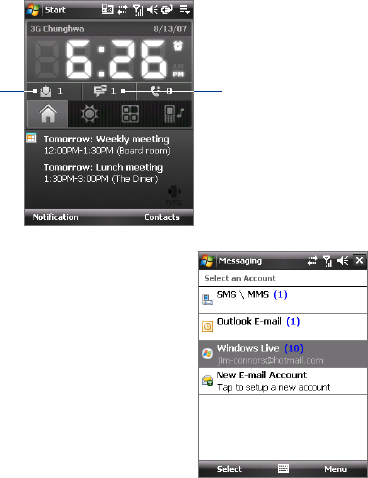
112 Exchanging Messages
7.1 Messaging
Messaging is where your text messages (SMS), multimedia messages
(MMS), and e-mails are located. When you receive new messages, you can
open them from the Today screen by tapping the type of message that you
want to open.
New e-mail messages New SMS and MMS
messages
To select a messaging account
Do one of the following:
• Tap Start > Messaging. The Account
Picker screen then appears where you
can select an account.
• While you are in a message list of a
certain account, for example SMS/MMS,
tap Menu > Go To to switch to other
types of messaging accounts.
To configure message account settings
Do one of the following:
• Tap Menu > Options on the Account
Picker screen.
• Tap Menu > Tools > Options while
you’re in a message list.
Account Picker screen
Exchanging Messages 113
To automatically add a signature in outgoing messages
You can automatically add your name and other information as your
signature in outgoing SMS, MMS and e-mail messages by following these
steps:
Tip You need to specify your signature for each type of messaging account.
1. Tap Start > Messaging, then tap Menu > Options.
2. Tap Signatures.
3. Select a type of messaging account in which to add a signature.
4. Select the Use signature with this account check box.
5. In the provided text box, enter the information that will be displayed
as your signature.
6. If you want the signature to be added whenever you reply or forward
messages, select the Use when replying and forwarding check box.
7. Repeat steps 3 to 6 to add a signature to the other types of messaging
accounts.
7.2 Text Messages
Send short text messages (SMS) up to 160 characters long to other mobile
phones.
Send text messages
To compose and send a text message
1. Tap Start > Contacts.
2. Slide your finger upward on the touch screen to scroll down the
contact list. See “Finger scrolling and finger panning” in Chapter 1 for
more details on finger scrolling.
3. Touch the contact’s name to open his or her contact card.
4. On the contact card, touch Send text message.
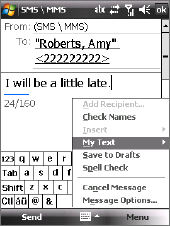
114 Exchanging Messages
5. A new text message is then created.
To add more recipients,
enter their mobile
phone numbers in the To field, separating
them with a semicolon. You can also
tap To if you want to add mobile phone
numbers from Contacts.
6. Enter your message.
•
To quickly add common messages,
tap Menu > My Text and tap a desired
message.
• To check the spelling, tap Menu >
Spell Check.
7. Tap Send.
Tips • To enter symbols, tap 123 on the on-screen keyboard and then tap a
symbol. For more information about entering text and symbols, see
Chapter 2.
• If you want to know when a text message is received, before sending the
message that you are composing, tap Menu > Message Options then
select the Request message delivery notification check box.
• To always receive a delivery notification, tap Menu > Tools > Options in
the text message list, tap SMS \ MMS, then select the Request delivery
notifications check box.
Copy text messages from and to the SIM card
1. Tap Start > Messaging > SMS \ MMS.
2. In the message list, select the text message you want to copy.
3. Do one of the following:
• To copy a text message to the SIM card, tap Menu > Copy to SIM.
• To copy a text message from the SIM card to your device, tap
Menu > Copy to Phone .
Note Text messages stored on your SIM card are automatically displayed in the
Inbox folder. Copying them to your device results in duplicate messages in
the Inbox folder when your SIM card is in use.
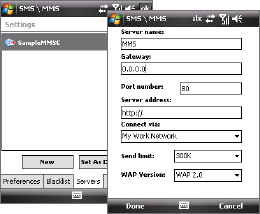
Exchanging Messages 115
7.3 MMS
Sending multimedia messages (MMS) to your friends and family is fun
and easy. You can include pictures, videos, and audio clips in a multimedia
message.
Notes • Multimedia messaging is a charged service and has to be provisioned
on your mobile account. Please contact your wireless service provider to
have MMS provisioned as part of your calling plan.
• Make sure the size of MMS messages that you send is within the limits
allowed by your wireless service provider.
Change MMS settings
Check your device to see if it is configured with your wireless service
provider’s MMS settings. If the MMS settings are not yet configured on your
device, you can add the settings while composing an MMS message.
To configure MMS message settings
1. Tap Start > Messaging > SMS \ MMS.
2. Tap Menu > MMS Options. The Settings screen then appears.
3. In the Preferences tab, select or clear the provided check boxes
according to your needs.
4. Tap the Servers tab and
check if your device is
preset with MMS server
settings.
If there are no preset
settings, tap New and
enter the following
information, which you
obtained from your
wireless service provider:
• Gateway. Location of the MMS server, which is usually in the form
of an IP address.
• Port number. HTTP port number used for connecting to the MMS
server and for file transfer.
116 Exchanging Messages
• Server address. URL address of the server where MMS messages
are stored.
• Connect via. Select the connection that your device uses for MMS
messages.
• Send limit. Select the maximum MMS message size allowed by
your wireless service provider.
• WAP version. Select either WAP 1.2 or WAP 2.0, depending on
which one is being used by your wireless service provider.
5. Tap Done.
Note • If your device already has preset MMS settings, it is recommended that
you do not change these settings. If you change the preset settings, your
device may not be able to send and receive MMS messages.
• If you add several MMS message service providers to the Settings screen,
you can choose one as your default provider. Select the provider's name
in the list then tap Set As Default.
Create and send MMS messages
You can compose MMS messages in a combination of slides, where each
slide can consist of a photo, video or audio clip, and/or text.
To compose an MMS message
1. Tap Start > Messaging > SMS \ MMS, then tap Menu > New > MMS.
2. When you see the Choose a MMS screen, tap a preset template, or tap
Custom to open a blank MMS message.
Note If you prefer to always create a blank MMS message, select the Always
choose custom check box.
3. In To, enter the recipient’s phone number or e-mail address directly,
or tap To, Cc, or Bcc to choose a phone number or an e-mail address
from Contacts.
Note You may need to scroll up to see Cc and Bcc.
4. Enter a subject for your message.
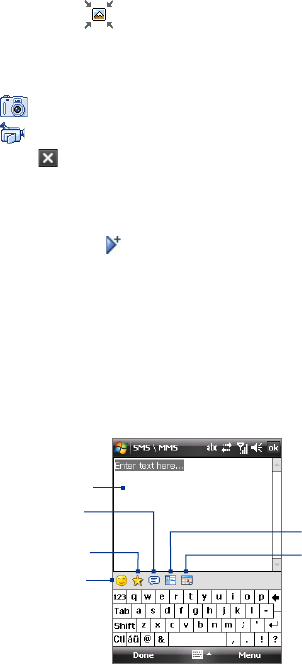
Exchanging Messages 117
5. Tap the Insert icon ( )to select and insert a photo or video clip.
When selecting a photo or video clip, you can:
• Tap Select to insert the selected photo or video clip into the MMS
message you are composing.
• Tap to take a photo and insert it into the MMS message.
• Tap to record MMS video and insert it into the MMS message.
• Tap Exit ( ) to quit selection and return to the MMS message.
6. Enter text and insert audio clips by tapping the respective areas. See
“To add text to an MMS message” and “To add an audio clip to an
MMS message” for details.
7. To add more slides, tap or tap Menu > Slides > Insert Slide. Repeat
steps 5 and 6 to insert photos/videos, text, and audio onto your slides.
8. Tap Send to send the MMS message.
Tip You can also send an MMS message from Pictures & Videos, Camera Album,
or the Camera program.
To add text to an MMS message
When you tap Insert text here on your MMS message, an empty screen
appears where you can enter your text. You can insert the following types of
information:
Enter your own text
Choose from common words
or phrases from the My Text list
Include a Favorites link
Add an emoticon
Insert contact
information
Insert calendar
appointment
Tip To edit or delete a phrase on the My Text list, tap and hold a string, then tap
Edit or Delete from the shortcut menu. To add a new phrase, tap New.
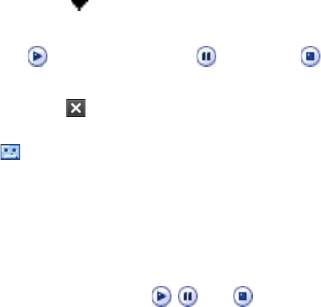
118 Exchanging Messages
To add an audio clip to an MMS message
You can add one audio clip per slide in your MMS message.
1. Tap Insert audio on your MMS message.
By default, My Documents will be shown. Tap My Music or another
folder that contains audio files. When navigating folders, tap the
Down arrow ( ) to return to the upper folder.
2. Select an audio file. When selected, you can:
• Tap to play the audio clip, to pause, or to stop playback.
• Tap Select to insert it into your MMS message.
• Tap Exit ( ) to quit selection and return to your MMS message.
• To record a new audio clip and add it to your MMS message, tap
. The Record pop-up window then opens. Tap Record to start
recording, and Stop to end the recording. Tap Play to listen to
the recorded audio clip, then tap Add. The new audio clip is then
inserted into your MMS message.
View and reply to MMS messages
To view an MMS message
• Use the playback controls , , and .
• Tap Contents to see a list of files included in the message. On the
Message Contents screen, you can do the following:
• To save a file, select it, and tap Menu > Save.
• To save the contents of a text file to the My Text list, tap Menu >
Save into My Text.
• To associate a photo to one of your contacts, tap Menu > Assign
to Contact.
To reply to an MMS message
On the message list, select the MMS message and do one of the following:
• Tap Menu > Reply > Reply to reply to the sender of the message.
• Tap Menu > Reply > Reply All to reply to all persons listed in To, Cc,
and Bcc of the message.
Exchanging Messages 119
To block a phone number from sending you MMS messages
If you do not want to receive MMS messages from a particular sender, you
can add the sender’s phone number to the MMS Blacklist.
1. When you receive a new MMS message, open and view the message.
2. To avoid receiving MMS messages from this sender next time, tap
Menu > Show > Message Detail.
3. On the MMS Detail screen, tap Menu > Show Contact Details.
4. Tap Menu > Save to Blacklist.
5. Tap Done.
Tip To view the Blacklist, on the message list tap Menu > MMS Options >
Blacklist tab.
To unblock a phone number and allow the sender to send you MMS
messages, remove the number from the Blacklist. Tap and hold the phone
number in the Blacklist then tap Delete.
7.4 Types of E-mail Accounts
You can set up the following types of e-mail accounts on your device:
• Outlook e-mail that you sync with your PC or the Exchange Server.
• E-mail account that you have from an Internet Service Provider (ISP).
• Web-based e-mail accounts such as Yahoo!® Mail, AOL®, etc.
• Work account that you access using a VPN connection.
120 Exchanging Messages
7.5 E-mail Setup Wizard
Windows Mobile’s E-mail Setup Wizard lets you easily set up your
personal and work e-mail accounts. You can add an e-mail account from an
Internet Service Provider (ISP) or other e-mail provider as well as web-based
accounts such as Gmail®, Yahoo!® Mail Plus, AOL®, etc.
Note For more information about setting up your company Outlook e-mail
account, see Chapter 8.
Set up your device to synchronize Outlook e-mail with
the computer
If you have installed the synchronization software on your PC and created a
partnership with your device, then your device is ready to send and receive
Outlook e-mail.
If you have not yet installed the synchronization software nor created a
partnership, please do so by following the procedures in Chapter 5.
Tip To set up your company e-mail account so that you can access Outlook
e-mail messages wirelessly, you must set up your device to synchronize via
a wireless LAN or over-the-air connection with your company’s Exchange
Server. For more information about synchronizing with your company e-mail
server, see Chapter 8.
Set up a POP3 or IMAP4 e-mail account
Set up a POP3 or IMAP4 e-mail account on your device if you have an e-mail
account from an Internet service provider (ISP) or other e-mail provider, or a
web-based account such as Gmail, Yahoo! Mail Plus, etc. You can also add a
work account that you access using a VPN server connection as a POP3/
IMAP4 account.
1. Tap Start > Messaging > New E-mail Account.
2. Enter your e-mail address, and select the Try to get e-mail settings
automatically from the Internet check box. By selecting the option,
the device attempts to download e-mail server settings so that you
do not need to enter them manually. Tap Next.
3. After Auto Setup finishes, tap Next.
Exchanging Messages 121
Note If Auto Setup is unsuccessful, select Internet e-mail from the Your
e-mail provider list on the next screen. You will also be asked to enter
e-mail server settings during the setup process. See “To specify e-mail
server settings” for details.
4. Enter your name. You can also edit the Account display name field to
specify the name of your ISP or e-mail provider. Tap Next.
5. Enter your login name if it does not show automatically in the User
name field. Also enter your password, and select the Save password
check box. Tap Next.
6. At this point, e-mail setup is complete. In the Automatic Send/
Receive list, choose how frequent you want e-mail messages to be
automatically sent and downloaded on your device.
Note Tap Review all download settings to select download options, set the
e-mail format as HTML or plain text, and more. For more information,
see “To customize download and format settings."
7. Tap Finish.
To specify e-mail server settings
If Auto Setup is unsuccessful, contact your ISP or e-mail provider for the
Incoming mail server and outgoing mail server settings so you can enter
them on your device.
Other options that you can select include the following:
• Select the Outgoing server requires authentication check box, if
required by your provider.
• If the outgoing e-mail server requires a different user name and
password for sending e-mail, clear the Use the same user name and
password for sending e-mail check box. You will be prompted to
enter this information.
• Tap Advanced Server Settings, then select the Require SSL check
boxes if your e-mail provider uses an SSL connection for more secured
e-mail. From the Network connection list, select the data connection
that you use for connecting to the Internet.

122 Exchanging Messages
To customize download and format settings
Before you tap Finish when setting up your POP3 or IMAP4 e-mail account,
you can tap Review all download settings to choose download options,
message format, and other settings.
Options Description
Automatic Send/Receive You can select a time interval for connecting to
the Internet automatically to send and receive
messages.
Download messages Set the number of days of messages that you
want to be downloaded to your device.
Send/receive when I click
Send
By default, messages are immediately delivered
when you tap Send. If you prefer to save
outgoing messages to the Outbox folder first,
clear the check box. (In this case, you will need
to manually send messages by tapping Menu >
Send/Receive).
Use automatic send/
receive schedule when
roaming
This allows your device to data roam when
there is a set time interval for connecting to the
Internet automatically. Since this may result in
higher connection costs, you may want to leave
the check box cleared.
When deleting messages Choose whether to delete messages from the
mail server when you delete them on your device.
Message format Select HTML or Plain Text.
Message download limit Select the e-mail download size. If you have large
volumes of e-mail, use a lower size or select to
download headers only.
Exchanging Messages 123
7.6 Using E-mail
After setting up e-mail accounts on your device, you can start sending and
receiving e-mail messages.
Create and send messages
To compose and send a message
1. Tap Start > Contacts.
2. Slide your finger upward on the touch screen to scroll down the
contact list. See “Finger scrolling and finger panning” in Chapter 1 for
more details on finger scrolling.
3. Touch the contact’s name to open his or her contact card.
4. On the contact card, touch the item that shows Send e-mail.
5. If you have several e-mail accounts, the Account Picker screen will
appear. Select an e-mail account that you want to use.
6. A new e-mail message is then created.
To add more recipients, enter their e-mail addresses, separating
them with a semicolon. You can also tap To if you want to add e-mail
addresses stored in Contacts.
7. Enter a subject and compose your message. To quickly add common
messages, tap Menu > My Text and tap a desired message.
8. To check the spelling, tap Menu > Spell Check.
9. Tap Send.
Tips • To enter symbols, tap 123 on the on-screen keyboard and then tap a
symbol. For more information about entering text and symbols, see
Chapter 2.
• To set the priority, tap Menu > Message Options.
• If you are working offline, e-mail messages are moved to the Outbox
folder and will be sent the next time you connect.
To add an attachment to a message
1. In the message that you are composing, tap Menu > Insert and tap
the item you want to attach: Picture, Voice Note, or File.
2. Select the file or picture you want to attach, or record a voice note.
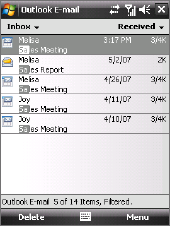
124 Exchanging Messages
Filter the Inbox message list
When the Inbox on your device is full of messages, it may be difficult to
browse and locate a desired message. You can filter your Inbox to display
only the messages that contain a particular sender or subject you are
searching for.
To filter your Inbox
• Enter the sender name or e-mail subject you want to look for using
the on-screen keyboard. As you tap keys, the message list narrows
down to the conditions you have set.
For example, tapping “S”, then “A”
narrows the list to only the e-mails
that contain sender names and e-mail
subjects that start with “SA.”
View and reply to messages
To read an incoming message
By default, only the first few kilobytes of a message are shown when you
open an incoming message. To read the whole message do one of the
following:
• Finger-scroll to the end of the message and tap Get the rest of this
message.
• Tap Menu > Download Message.
The message will be downloaded the next time you tap Menu > Send/
Receive to send and receive e-mail.
Note If your company is running Microsoft Exchange Server 2007, the message
downloads immediately without waiting until the next time you synchronize.
For more information about working with company e-mails, see Chapter 8.
Exchanging Messages 125
To download an attachment
An attachment appears below the subject of the message. Tapping the
attachment opens the attachment if it has been fully downloaded or marks
it for download the next time you send and receive e-mail.
Notes • If there are multiple attachments in the message, all attachments are
downloaded.
• For information about setting your device to automatically download file
attachments, see "Customize e-mail settings".
• If your company is running Microsoft Exchange Server 2007, the
attachment downloads immediately, without waiting until the next time
you synchronize. For more information about working with company
e-mails, see Chapter 8.
To reply to or forward a message
1. Open the message and tap Menu > Reply, Menu > Reply All, or
Menu > Forward.
2. Enter your response then tap Send.
Tip You can customize ActiveSync to exclude addresses, including your own,
from being added to the recipient list. Tap Menu > Options in ActiveSync,
select the E-mail item, tap Settings, then tap Advanced. In the My e-mail
addresses text box, enter e-mail addresses you want to exclude.
To view and reply to HTML e-mails
You can receive, view and reply to HTML e-mails from any type of e-mail
account. The HTML format is retained, without layout shifting or resizing.
Note HTML e-mail support in Outlook Mobile is available only if your company is
using Microsoft Exchange Server 2007.
1. Set the message format to HTML. To find out how to set the message
format, see “Customize e-mail settings”.
2. Tap Start > Messaging, select your e-mail account, and open an
HTML e-mail that you received.
3. Tap the Tap to scroll right option to be able to scroll sideways and
get a complete horizontal view of the message.
4. Tap Get the rest of this message that’s shown at the bottom of the
message to download and view the whole message.
126 Exchanging Messages
5. If the e-mail does not download immediately, tap Menu > Send/
Receive.
6. If images do not immediately appear on the message, tap Internet
pictures blocked then tap Download Internet pictures.
7. Tap Menu and choose whether to reply or forward the message.
8. Enter your response then tap Send.
Tip E-mail can contain hyperlinks to web pages.
Download messages
The manner in which you download messages depends on the type of
e-mail account you have.
To send and receive e-mail for an Outlook account
1. Connect your device to your PC using the USB cable or Bluetooth.
Otherwise, connect wirelessly if you are synchronizing Outlook
e-mail with the Exchange Server. For more information, see Chapter 8.
2. Synchronization automatically begins, and your device sends and
receives Outlook e-mail.
Tip You can also manually synchronize anytime by tapping Sync in ActiveSync or
Menu > Send/Receive in Outlook Mobile.
To send and receive e-mail for a POP3/IMAP4 account
If you have an e-mail account with an ISP or a work account that you access
using a VPN server connection, you send and receive messages through a
remote e-mail server. Before sending and downloading messages, you need
to connect to the Internet or your corporate network.
1. Tap Start > Messaging and tap your POP3 or IMAP4 e-mail account.
2. Tap Menu > Send/Receive. Messages on your device and e-mail
server are synchronized: new messages are downloaded to the device
Inbox folder, messages in the Outbox folder are sent, and messages
deleted from the server are removed from the device Inbox.
Exchanging Messages 127
Customize e-mail settings
To change the download size and format for Outlook e-mail
1. Disconnect your device from the computer.
2. Tap Start > Programs > ActiveSync.
3. Tap Menu > Options, select E-mail, then tap Settings.
4. On the E-mail Sync Options screen:
• Under Message format, select HTML or Plain text.
• Under Download size limit, select the desired e-mail size.
5. Close ActiveSync and reconnect your device to the computer.
To change the download size and format for POP3/IMAP4 e-mail
1. Tap Menu > Options on the Account Picker screen, or tap Menu >
Tools > Options while you’re in a message list.
2. Tap your e-mail account.
3. Keep tapping Next until you see Message format and Message
download limit on the screen.
4. Under Message format, select HTML or Plain text.
5. Under Download size limit, select the desired e-mail size.
6. Tap Finish.
To automatically receive attachments on Outlook e-mails
1. Tap Start > Programs > ActiveSync.
2. Tap Menu > Options.
3. Tap E-mail > Settings, then select Include file attachments.
To automatically receive attachments on IMAP4 e-mails
1. Tap Start > Messaging.
2. Tap Menu > Options.
3. Tap the name of your IMAP4 account.
4. Keep tapping Next until you see the Download attachments item on
the screen.

128 Exchanging Messages
5. Select a download size from the Download attachments smaller
than list box.
6. Tap Finish.
To store attachments on a storage card
1. Tap Start > Messaging.
2. Tap Menu > Options > Storage tab.
3. Select the When available, use this storage card to store
attachments checkbox.

Chapter 8
Working With Company E-mails
and Meeting Appointments
8.1 Synchronizing with the
Exchange Server
8.2 Working With Company E-mails
8.3 Managing Meeting Requests
8.4 Finding Contacts in the
Company Directory
130 Working With Company E-mails and Meeting Appointments
8.1 Synchronizing with the Exchange Server
To keep up-to-date with your company e-mails and meeting schedules
while you’re out of the office, you can connect your device to the Internet
wirelessly and synchronize with your company’s Exchange Server.
Set up an Exchange Server connection
Before you can synchronize or access information on the Exchange Server,
you need to set up an Exchange Server connection on your device. You
need to get the following information from your network administrator and
enter them on your device:
• Exchange Server name (must be Outlook Web Access server name)
• Domain name
• User name and password that you use at work
If you have not synchronized your device with your PC, follow these steps to
set up an Exchange Server connection.
1. Tap Start > Messaging > New E-mail Account.
2. Enter your e-mail address. Clear the Try to get e-mail settings
automatically from the Internet check box, then tap Next.
3. Select Exchange server in the Your e-mail provider list, then tap
Next.
4. Tap Next again.
5. In Server address, enter the Exchange Server name, and tap Next.
6. Enter your user name, password, and domain, and tap Next.
Tip To change the rules for resolving synchronization conflicts, tap
Advanced.
7. Select the items that you want to sync with the Exchange Server.
8. To change synchronization settings of an information type, for
example, E-mail, select the type of information, and tap Settings.
9. Tap Finish.
Note If you synchronized e-mails with your PC before, open ActiveSync on
your device and tap Menu > Add Server Source to set up an Exchange
Server connection. When you're prompted to select information types for
synchronization, you need to clear the E-mail check box under the Windows
PC item first before you can select E-mail under Exchange Server.
Working With Company E-mails and Meeting Appointments 131
Tip To change Exchange Server settings, open ActiveSync then tap Menu >
Configure Server.
Start synchronization
Before you start synchronizing with the Exchange Server, make sure your
device has been set up with a data connection to the Internet so that you
can synchronize wirelessly. For more information about connections, see
Chapter 10.
After you finish setting up an Exchange Server connection, your device
automatically starts synchronization.
You can manually start synchronization anytime by tapping Sync in
ActiveSync.
Note If you connect your device to your office computer via a USB or Bluetooth
connection, you can use this connection to the PC to “pass through” to the
network and download Outlook e-mails and other information to your
device.
8.2 Working With Company E-mails
Your device gives you instant access to your company e-mails and lets
you manage your messages easier. Direct Push, Fetch Mail, Remote e-mail
search, and e-mail flags are just some of the tools you can use to manage
your e-mails.
Note Some messaging features depend on the Microsoft Exchange Server version
used in your company. Please check with your network administrator for the
availability of these features.
Automatic synchronization through Direct Push
Direct Push technology (push e-mail feature) enables you to receive new
e-mails on your device as soon as they arrive in your Inbox on the Exchange
Server. With this feature, items such as contacts, calendar and tasks are
also immediately updated onto your device when these items have been
changed or new entries have been added on the Exchange Server. To make
Direct Push work, you need to have a GPRS connection on your device.
132 Working With Company E-mails and Meeting Appointments
You need to perform a full synchronization between your device and the
Exchange Server first before Direct Push can be enabled.
Requirement The Direct Push feature works for your device only if your company
is using Microsoft Exchange Server 2003 Service Pack 2 (SP2)
with Exchange ActiveSync or higher version.
To enable Direct Push via Comm Manager
1. Tap Start > Programs > Comm Manager.
2. On the Comm Manager screen, tap the DirectPush button to enable
or disable DirectPush.
When enabled, the ON indicator is activated, which indicates that
you will receive e-mails as they arrive. When disabled, you need to
manually retrieve your e-mails.
To enable Direct Push via ActiveSync
1. In ActiveSync on your device, tap Menu > Schedule.
2. Select As items arrive in the Peak times and Off-peak times boxes.
Note When both the GPRS and Wi-Fi connections are turned on at the same
time, the Direct Push feature will always opt for Wi-Fi.
Scheduled synchronization
If you do not want to use Direct Push, you can set a regular schedule for
synchronizing Outlook e-mail and information.
1. In ActiveSync on your device, tap Menu > Schedule.
2. Select a shorter time interval in the Peak times box for you to be able
to receive e-mails more frequently. (Peak times which usually refer to
your working hours when e-mail volume is high).
3. Select a longer interval in the Off-peak times box.
Tip To set the days and hours that make up your peak and off-peak times,
tap Adjust peak times to fit your schedule.
Working With Company E-mails and Meeting Appointments 133
Instant download through Fetch Mail
The Fetch Mail feature downloads an entire e-mail immediately without the
need for you to perform a full Send/Receive action. This limits the download
to just the e-mail message that you want and helps save data cost.
Requirement Fetch Mail works for your device only if your company is using
Microsoft Exchange Server 2007 or higher.
1. Tap Start > Messaging > Outlook E-mail.
2. Tap an e-mail message to open it.
3. By default, only the first few kilobytes of the message is shown. To
download the whole e-mail, finger-scroll to the end of the message
then tap Get the rest of this message.
4. A “Downloading message” status appears. Wait for the remainder of
the message body to be downloaded.
Tip For information about changing e-mail sync options such as the initial
download size limit for e-mail, see "Customize e-mail settings" in Chapter 7.
Note When you receive an e-mail that contains a link to a document such as a PDF
or Microsoft Office document located on SharePoint or an internal file server,
you can tap the link to view the document on your device. You can view the
document only if you have a Microsoft Outlook account that synchronizes
with Microsoft Exchange Server 2007 or later. Exchange Server must also
be set up to allow access to SharePoint document libraries or internal file
servers.
Search for e-mails on the Exchange Server
You can access messages that are not available on your device by searching
your Microsoft Exchange Server mailbox. The search results will be
downloaded and displayed in a Search Results folder.
Requirement Your company must be using Microsoft Exchange Server 2007 or
higher.
1. Tap Start > Messaging > Outlook E-mail.
2. Tap Menu > Tools > Search Server.
3. In the Look for text box, enter the search keyword.
4. Choose the date range of messages to search from.
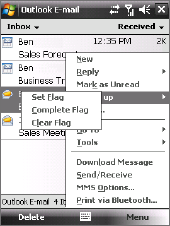
134 Working With Company E-mails and Meeting Appointments
5. From the Look in list, choose whether to search from your inbox or
outbox only or to search all folders.
6. Tap Search.
Flag your messages
Flags serve as a reminder for you to follow-up on important issues or
requests contained in e-mail messages. Flagging messages, which has been
a useful feature on desktop Outlook E-mail, can also be done in Outlook
Mobile on your device. You can flag received e-mail messages on your
device.
Requirement Flags are enabled only if e-mails are synchronized with Microsoft
Exchange Server 2007 or higher. Flags are disabled or hidden
if e-mails are synchronized with earlier versions of Microsoft
Exchange Server.
To flag or unflag a message
1. Tap Start > Messaging > Outlook
E-mail.
2. Select a message or open a message.
3. Tap Menu > Follow Up and select one
of the following options:
• Set Flag Mark the message with
a red flag to indicate that it needs
follow up.
• Complete Flag Mark the message
with a check mark to indicate that
the issue or request in the e-mail is
already completed.
• Clear Flag Remove the flag to
unmark the message.
Note E-mail message reminders are displayed on your device if the messages are
flagged with reminders and synchronized from the Exchange Server.
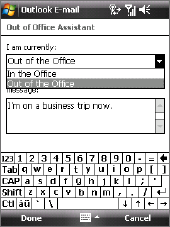
Working With Company E-mails and Meeting Appointments 135
Out-of-office auto-reply
Outlook Mobile allows you to retrieve and
change your out-of-office status. Just like
desktop Outlook E-mail, Outlook Mobile
automatically sends an auto-reply message
when you’re not available.
To send out-of-office auto-reply messages
1. Tap Start > Messaging > Outlook
E-mail.
2. Tap Menu > Tools > Out of Office.
3. From the I am currently list, select Out
of the Office.
4. Enter your auto-reply message then
tap Done.
8.3 Managing Meeting Requests
When you schedule and send meeting requests from your device, you can
invite attendees to your meeting and check their status to know about their
availability.
When you receive a meeting request, you can reply by accepting or
declining the request. The meeting request also clearly indicates whether or
not there are conflicting or adjacent meetings.
Requirement Your company must be using Microsoft Exchange Server 2007 or
higher.
To reply to a meeting request
1. When you receive a meeting request e-mail, a notification will be
displayed on the Today screen. Open the e-mail.
2. Tap Accept to reply and accept the meeting request, or tap Menu >
Decline if you cannot attend the meeting.
Tips • Before responding, you can check your availability during the time
of the requested meeting by tapping View your calendar.
• If the time of the meeting conflicts with your other appointments,
a “Scheduling Conflict” status appears on top of the e-mail.
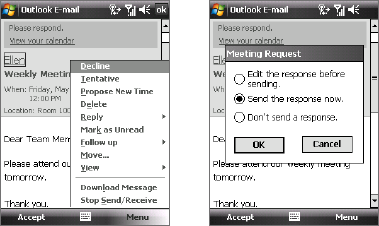
136 Working With Company E-mails and Meeting Appointments
3. Choose whether or not to edit your response e-mail before sending
then tap OK:
4. If you accepted the meeting request, it will automatically be added as
an appointment in Calendar on your device.
To view the list of meeting participants
1. Tap Start > Calendar.
2. Tap a meeting request that you previously sent, then tap Attendees.
The list of required and optional attendees will be listed.
Notes • For information about creating a meeting request, see “To send a meeting
request” in Chapter 6.
• If you select a meeting that you have organized, the list shows who has
accepted or declined the meeting.
• To view an attendee’s contact information, tap the attendee’s name. If
the attendee is included in your contacts list, you will see the contact
information immediately. If the attendee is not in your contacts list, tap
Company Directory to view the contact information.
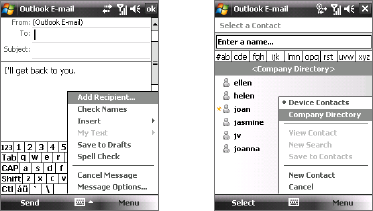
Working With Company E-mails and Meeting Appointments 137
8.4 Finding Contacts in the Company Directory
In addition to having contacts on your device, you can access contact
information from your organization’s Company Directory. By having
over-the-air access to the Company Directory, you can easily send e-mail
messages and meeting requests to anyone in your company.
Requirement Access to the Company Directory is available only if your
organization is running Microsoft Exchange Server 2003 SP2 or
higher, and you have completed your first synchronization with the
Exchange Server.
1. Synchronize with Exchange Server if you have never done so.
2. Do any of the following:
• In Contacts, tap Menu > Company Directory.
• In a new e-mail message, tap the To box (or tap Menu > Add
Recipient) then tap Company Directory at the top of the list.
• In a new meeting request using Calendar, tap Attendees and then
tap Company Directory at the top of the list.
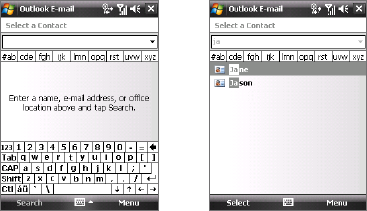
138 Working With Company E-mails and Meeting Appointments
3. Enter a partial or full contact name and tap Search. In the search
results list, tap a contact to select it.
Notes • You can save a contact from the Company Directory to your device by
selecting the contact then tapping Menu > Save to Contacts.
• You can search on the following information as long as that information is
included in the Company Directory: First name, Last name, E-mail name,
Display name, E-mail address, or Office location.

Chapter 9
Working With Documents
and Files
9.1 Microsoft® Office Mobile
9.2 Adobe® Reader® LE
9.3 Copying and Managing Files
9.4 ZIP
9.5 Backing Up Data
140 Working With Documents and Files
9.1 Microsoft® Office Mobile
Microsoft® Office Mobile consists of the following applications:
• Microsoft® Office Word Mobile lets you create and edit documents
and templates in Word Mobile and save them as *.doc, *.rtf, *.txt,
and *.dot files.
• Microsoft® Office Excel® Mobile lets you create and edit Excel
workbooks and templates on your device.
• Microsoft® Office PowerPoint® Mobile allows you to view (not
create) slide show presentations in *.ppt and *.pps formats.
To use Microsoft Office Mobile
1. Tap Start > Office Mobile.
2. Tap the Office Mobile application that you want to use.
Notes • Word Mobile does not fully support some features of Microsoft® Office
Word such as revision marks and password protection. Some data and
formatting may be lost when you save on your device a Word document
that was created in Office Word on the PC. To see a complete list of
features that are not supported in Word Mobile, see Help on your device.
• Excel Mobile does not fully support some features such as formulas and
cell comments. Some data and formatting may be lost when you save on
your device an Excel workbook that was created in Office Excel on the PC.
To see a complete list of features that are not supported in Excel Mobile,
see Help on your device.

Working With Documents and Files 141
9.2 Adobe® Reader® LE
Adobe® Reader® LE is an application for viewing PDF (Portable Document
Format) documents on your device. It supports a subset of the features
found in the PC versions of Adobe Reader.
To open Adobe Reader LE
• Tap Start > Programs > Adobe Reader LE.
To open a PDF file on your device
Do one of the following:
• Open a PDF file in Adobe Reader LE.
• Open File Explorer and find the desired PDF file, then tap the file to
open it.
To navigate through a PDF document
When you are viewing a PDF document, you can do any of the following:
• Use the vertical and horizontal scroll bars (including the Up, Down,
Right and Left arrow keys on the bars) to move to the desired
direction of the page.
• Press NAVIGATION up/down/right/left to move to the desired
direction of the page.
• Tap to move to the previous page; tap to move to the next page.
Tap to jump to the first page; tap to jump to the last page.
• Tap Tools > Go To to select the desired page to view.
To search for text in the document
1. Tap Tools > Find > Text or tap on the toolbar.
2. Type in the text to be searched, then tap Find.
3. The matched text in the document will be highlighted.
4. To search for the next occurrence of the text, tap Tools > Find > Next.
Tips • Adobe Reader LE displays a bookmark pane for the PDF files that contain
bookmarks. Tap the bookmarks to go to a specific section/page within the
file.
• Adobe Reader LE supports password-protected PDF files with up to 128-
bit encryption. When you open a password-protected PDF file, you will be
prompted to enter the password before the file can be opened.
142 Working With Documents and Files
9.3 Copying and Managing Files
You can copy files between your device and PC, or copy files to a storage
card that is inserted on your device. You can also efficiently manage your
files and folders using File Explorer.
To copy files using Windows Mobile Device Center or ActiveSync
1. Connect your device to the PC.
2. Click File Management > Browse the contents of your device in
Windows Mobile Device Center or click Explore in ActiveSync on
your PC. This opens Windows Explorer on your PC and displays the
contents of your device.
3. To copy a file from your device to your PC:
a. Browse the contents of your device, right-click the file you want to
copy, then click Copy.
b. Right-click a folder in your PC, then click Paste.
4. To copy a file from your PC to your device:
a. Browse the folders on your PC, right-click the file you want to copy,
then click Copy.
b. Right-click a folder on your device, then click Paste.
To manage files on your device using File Explorer
File Explorer lets you browse and manage the contents of your device. The
root folder on the device is named My Device, and contains the following
folders: My Documents, Program Files, Windows, and more.
1. Tap Start > Programs > File Explorer.
2. Tap a folder or file to open it.
3. To return to an upper level folder, tap Up and select the folder.
4. To quickly delete, rename, or copy a file, tap and hold the file then
choose the desired operation from the shortcut menu. To copy or
delete multiple files, tap and drag over the desired files to select, tap
the selection, then choose the desired operation from the shortcut
menu.

Working With Documents and Files 143
To copy files to a storage card
1. Make sure the storage card is properly inserted into your device.
2. Tap Start > Programs > File Explorer and navigate to the
appropriate folder.
3. Tap and hold the file you want to copy, and tap Copy.
4. Tap the Down arrow ( ) then tap Storage Card from the list.
5. Tap Menu > Edit > Paste.
Tip You can configure programs such as Word Mobile and Excel Mobile to
directly save edited files on your storage card. In the program's file list, tap
Menu > Options then select the storage card in the Save to box.
9.4 ZIP
The ZIP program increases the storage capacity of your device by allowing
you to compress files in the conventional ZIP format. It also allows you to
extract files from a zip file.
To start ZIP on your device
• Tap Start > Programs > ZIP.
Each time you start ZIP, it searches for files that have the .zip file
extension, and displays these files on the Archive List screen.
To open a ZIP file and extract files
1. Open a zip file by doing one of the following:
• Select a file and tap File > Open Archive.
• Tap and hold a file and tap Open Archive.
• Double-tap a file.
Note You cannot select multiple ZIP files.
2. From the zip file, select files by doing one of the following:
• Tap to select a file.
• To select several files, tap Menu > Action and make sure Multi-
Select Mode is selected. Select files by tapping each file. (Tap a
selected file to deselect it).
• To select all files, tap Menu > Action > Select All.
144 Working With Documents and Files
3. Tap Menu > Action > Extract.
4. Choose a folder in which files will be extracted to, then tap Extract.
To create a zip archive
1. Tap File > New Archive.
2. On the Save As screen, enter a zip file name and choose a folder in
which to save the zip file. You can also choose whether the zip file will
be saved on the device’s main memory or storage card.
3. Tap Save.
4. Tap Menu > Action > Add.
5. Double-tap the folder that contains the files you want to archive.
6. Select files by doing one of the following:
• Tap to select a file.
• To select several files, tap and hold on the screen, then select
Multi-Select Mode. Select files by tapping each file. (Tap a
selected file to deselect it).
• To select all files, tap and hold on the screen, then tap Select All.
7. Tap Add.
8. Tap Menu > File > Close Archive.
9.5 Backing Up Data
Use Sprite Backup to back up data, which includes settings, files, contacts,
and all other information, to a storage card or to a designated folder on
your device.
To install Sprite Backup
1. Make sure your device is connected to your computer via a USB cable.
2. Insert the Application Disc on your computer’s CD or DVD drive and
install Sprite Backup to your device. Follow the on-screen instructions
on your computer to complete the installation.
3. After the installation is completed, the Setup Wizard on your
computer will set up Sprite Backup on your device. Follow the on-
screen instructions to complete the setup.
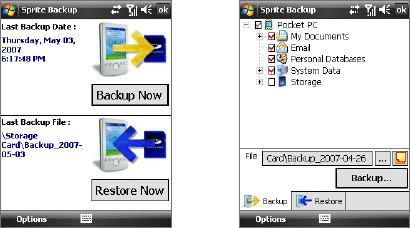
Working With Documents and Files 145
To open Sprite Backup
• On your device, tap Start > Programs > Sprite Backup.
Sprite Backup operates in two different modes: Basic mode and
Advanced mode.
Basic mode Advanced mode
To back up data in Basic mode
Basic mode is the default mode, and allows you to easily back up your entire
device with the tap of a button.
Note To change backup options or location, you will need to do it in Advanced
mode.
1. On the Basic mode screen, tap Backup Now.
2. Specify a password (between 6 to 15 characters in length) for the
backup file. Enter this password twice, then tap OK.
3. Follow the on-screen instructions to complete the backup.
To restore data in Basic mode
1. On the Basic mode screen, tap Restore Now.
2. Enter the password for the backup file, then tap OK.
3. Follow the on-screen instructions to complete the restoration process.

146 Working With Documents and Files
To back up data in Advanced mode
Advanced mode is designed for users with more advanced backup
requirements.
1. Tap Options > Switch to Advanced Mode.
2. In the Backup tab, you will see a tree view of the data and files on
your device. Tap the ‘+’ symbol at the left of an item to view its sub-
items. Use the check boxes to select or exclude items for backup.
3. Tap the Backup button and follow the on-screen instructions to
complete the backup.
To restore data in Advanced mode
1. On the Advanced mode screen, tap the Restore tab.
2. If there is a most recent backup file, this file will be displayed with its
contents. Otherwise, if you want to use an older backup file, tap
then select the desired file.
If the backup file is password protected, the password must be
entered before the backup file can be displayed in the tree view.
3. In the tree view, select the items you want to be restored.
4. Tap Restore and follow the on-screen instructions to restore.
Note In both the Basic and Advanced modes, Sprite Backup soft resets your device
first before it begins the backup or restoration process. It soft resets again
after the operation is completed.
To change the backup location and file name
1. On the Advanced mode screen, tap the Backup tab.
2. Tap then enter the backup file name and choose whether to save
the file to the Storage Card or the My Documents folder on your
device.
3. Tap OK.
To enable remote backup to a computer
1. On the Advanced mode screen, tap Options > Networking.
2. Select the Enable Remote Backup check box and choose whether to
do the remote backup to your PC via ActiveSync or network.
For more information about using Sprite Backup, see Help on your device.

Chapter 10
Getting Connected
10.1 Comm Manager
10.2 Connection Setup
10.3 Ways of Connecting to
the Internet
10.4 Wi-Fi
10.5 GPRS/3G
10.6 Dial-up
10.7 Starting a Data Connection
10.8 Internet Explorer® Mobile
10.9 Windows Live™
10.10 Using Your Device as a Modem
(Internet Sharing)
10.11 Bluetooth
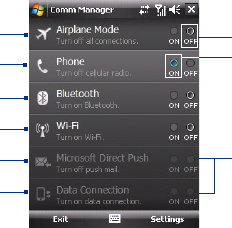
148 Getting Connected
10.1 Comm Manager
Comm Manager acts like a central switch that lets you enable or disable
phone features as well as manage your data connections easily.
To open Comm Manager
• Tap Start > Settings > Connections tab > Comm Manager.
• Tap Start > Programs > Comm Manager.
1
3
2
4
5
6
Off/disabled
On/enabled
Unavailable
1Tap to switch Airplane mode on or off. Turning on Airplane mode turns off the
phone, Bluetooth and Wi-Fi functions. For more information, see "Airplane Mode"
in Chapter 3.
2Tap to switch the phone on or off. Tap Settings > Phone to set the ring tone and
other phone settings. See Chapter 4 for details.
3Tap to switch Bluetooth or off. Tap Settings > Bluetooth to configure Bluetooth
on your device. See "Bluetooth" in this chapter for details.
4Tap to switch Wi-Fi on or off. Tap Settings > Wireless LAN to configure Wi-Fi on
your device. See "Wi-Fi" in this chapter for details.
5Tap to switch between automatically receiving (as items arrive) or manually
retrieving Outlook e-mails. See Chapter 8 for details.
6Tap to disconnect active data connections (e.g. 3G). You cannot reconnect a data
connection in Comm Manager.
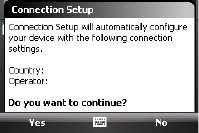
Getting Connected 149
10.2 Connection Setup
Connection Setup configures your device’s data connections, such as
GPRS, WAP, and MMS, for you so that you do not need to enter the settings
manually onto your device. All you need to do is to select your network
operator, then Connection Setup does all the configuration for you.
To automatically detect the network operator
The first time you power on your device, or
when you insert a new SIM card and then
power on your device, Connection Setup
will display a notification message to inform
you that it will automatically configure your
device.
1. Tap Yes on the notification message.
Note If your SIM card supports multiple network operator profiles, the next
message that appears will display network profile choices. Select the
profile you want to use and tap OK.
2. Next, you will be asked if you want to automatically configure your
device to the proper network settings. Tap Yes.
Connection Setup configures your device’s data connection settings.
3. After the Connection Setup completes the configuration, tap Restart.
To manually select the network operator
You can also manually select your network operator from Connection
Setup’s settings screen. Connection Setup will then reconfigure your
device’s data connections settings based on the operator that you selected.
1. Tap Start > Settings > Connections tab> Connection Setup.
2. Select the network Country and Operator you want to use.
Note If you choose a Country and/or Operator that is different from the
installed SIM card network operator, you may not be able to access
network services.
3. Tap OK.
The next message that appears prompts you to confirm whether you
want to configure the data connection settings based on the selected
network.
150 Getting Connected
4. Tap Yes. Connection Setup configures the data connection settings.
5. After the Connection Setup completes the configuration, tap Restart.
10.3 Ways of Connecting to the Internet
Your device’s networking capabilities allow you to access the Internet
or your corporate network at work through wireless and conventional
connections. You can connect to the Internet through one of the following
connections:
• Wi-Fi
• GPRS, EDGE or 3G
• Dial-up
Note You can also add and set up the following connections:
• VPN: A VPN connection is used to access your corporate network by using
an existing Internet connection.
• Proxy: A Proxy connection is used to access the Internet using an existing
connection to your corporate or WAP network.
10.4 Wi-Fi
Wi-Fi provides wireless Internet access over distances of up to 300 feet (100
meters).
To use Wi-Fi on your device, you need access to a wireless access point or
“hotspot”.
Note The availability and range of your device’s Wi-Fi signal depends on the
number, infrastructure, and other objects through which the signal passes.
Turn Wi-Fi on and off
1. Tap Start > Programs > Comm Manager.
2. Tap the Wi-Fi button to enable/disable the wireless function.
When enabled, the ON indicator is activated and available wireless
networks will be detected.
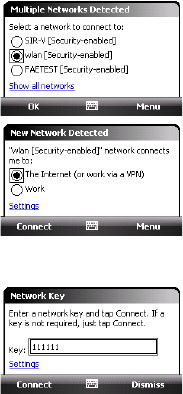
Getting Connected 151
Connect to wireless networks
After Wi-Fi is turned on in Comm Manager, your device scans for available
wireless networks in your area.
To connect to a wireless network
1. The network names of the detected
wireless networks are displayed on
a pop-up message window. Tap the
desired wireless network, then tap OK.
2. On the next pop-up message window,
do one of the following:
• Tap The Internet if the wireless
network connects your device to
the Internet.
• Tap Work if the wireless network
connects your device to a private
network.
3. If the wireless network is secured by
a network key, enter the key, then tap
Connect.
Next time you use your device to detect wireless networks, you will not see
the pop-up message windows again, and you will not be prompted to enter
the network key of the previously accessed wireless network (unless you
perform a hard reset which will erase custom settings on your device).
Note Wi-Fi networks are self-discoverable, which means no additional steps are
required for your device to connect to a Wi-Fi network. It may be necessary
to provide a username and password for certain closed wireless networks.
To check wireless network status
You can check the current wireless connection status from any of the
following screens of your device:
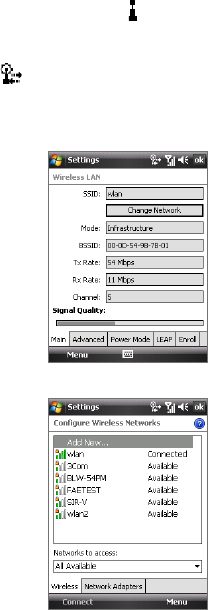
152 Getting Connected
• Title bar.
When you enable Wi-Fi on your device, the Wi-Fi ON icon appears on
the title bar.
After Wi-Fi is turned on, your device scans for available wireless
networks and the wireless signal icon appears on the title bar. The
arrows in this icon move back and forth while your device is scanning
for a wireless network signal. Once your device successfully connects
to a wireless network, the arrows stop moving.
• Wi-Fi Status screen.
Tap Start > Settings > Connections
tab > Wireless LAN > Main tab to see
the name of the wireless network that
your device is currently connected to.
The configuration and signal quality of
the wireless network are also shown.
• Configure Wireless Networks screen.
Tap Start > Settings > Connections
tab > Wi-Fi > Wireless tab. This
screen displays the wireless networks
currently available.
To connect to a wireless network in
the list, tap and hold on the desired
network, then tap Connect.
Tap a wireless network in the list to
view or change its connection settings.
You can also add new wireless
networks, if available, by tapping Add
New.
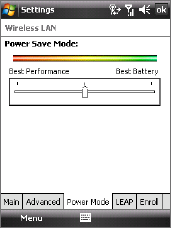
Getting Connected 153
To save battery power while connected to a wireless network
Using Wi-Fi quickly consumes battery power. Turn off Wi-Fi when not in use.
You can also enable power saving settings.
1. Tap Start > Settings > Connections
tab > Wireless LAN.
2. On the Power Mode tab, move the
Power Save Mode slider to a position
that optimizes performance with the
least power consumption.
For example, move the slider to
the left (Best Performance) to
have the optimal wireless network
performance; move to the right (Best
Battery) to obtain the maximum
battery usage.
10.5 GPRS/3G
Use GPRS/3G (or EDGE, if available) to connect to the Internet and to send
and receive picture messages on your device. You will need a data plan
to use your wireless service provider’s GPRS/3G network. Check with your
wireless service provider to find out about GPRS/3G rates.
GPRS/3G settings are already preconfigured on your device, and your device
is ready to use your wireless service provider’s GPRS/3G services. Do not
change the settings as this may cause services to stop working.
To add a new GPRS/3G connection
In times when you need to add another GPRS/3G connection on your
device, obtain the Access point name from your wireless service provider.
Also, check if a user name and password are required.
1. Tap Start > Settings > Connections tab > Connections.
2. Under My ISP, tap Add a new modem connection.
3. On the Make New Connection screen, enter a name for the
connection.
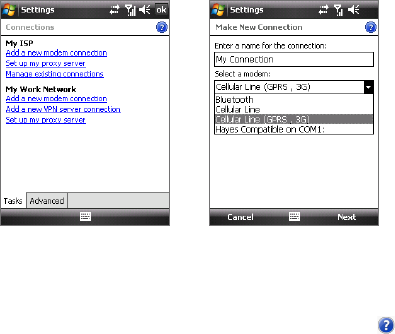
154 Getting Connected
4. In the Select a modem list, select Cellular Line (GPRS, 3G), then tap
Next.
5. Enter the Access point name, then tap Next.
6. Enter the user name and password, only if required.
7. Tap Finish.
Notes • To view help information for any screen, tap the help icon ( ).
• To modify your connection settings, tap Manage existing connections
on the Connections screen, and complete the connection wizard.
10.6 Dial-up
To set up a dial-up connection to your Internet Service Provider (ISP) on
your device, you need the same settings that you normally use when you
dial up from your computer. This includes the ISP server phone number,
your user name and password.
1. Tap Start > Settings > Connections tab > Connections.
2. Under My ISP, tap Add a new modem connection.
3. On the Make New Connection screen, enter a name for the
connection.
4. In the Select a modem list, select Cellular Line, then tap Next.
5. Enter the ISP server phone number, then tap Next.

Getting Connected 155
6. Enter your user name, password, and any other information required
by your ISP.
7. Tap Finish.
10.7 Starting a Data Connection
After setting up a data connection such as GPRS or ISP dial-up on your
device, you can now connect your device to the Internet. The connection
is started automatically when you begin using a program that accesses the
Internet such as Internet Explorer® Mobile.
To manually start a data connection
If you have set up multiple types of data connections on your device, you
can manually start a connection.
1. Tap Start > Settings > Connections tab > Connections.
2. Tap Manage existing connections.
3. Tap and hold the name of the desired connection, then tap Connect.
To disconnect active data connections
1. Tap Start > Programs > Comm Manager.
2. Tap the Data Connection button.
Note You cannot reconnect a data connection in Comm Manager.
10.8 Internet Explorer® Mobile
Internet Explorer® Mobile is a full-featured Internet browser, optimized for
use on your device.
To open Internet Explorer® Mobile
• Tap Start > Internet Explorer.
To go to a Web site
• Enter the Web site address in the Address Bar, then tap .
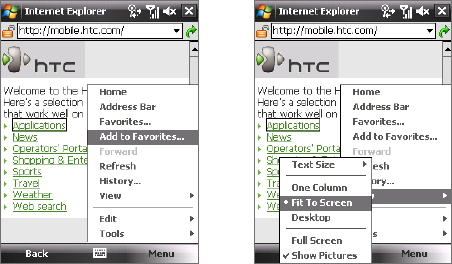
156 Getting Connected
To view a Web page using finger scrolling and panning
• Slide your finger upward to scroll down the Web page, or slide your
finger downward to scroll up the Web page.
• To pan downward, touch and hold on the touch screen then drag
your finger upward. To pan upward, touch and hold on the touch
screen then drag your finger downward.
• To pan towards the right, touch and hold on the touch screen then
drag your finger to the left. To pan towards the left, touch and hold on
the touch screen then drag your finger to the right.
• To pan freely around a Web page, touch and hold on the touch screen
then drag your finger in the desired direction.
For more information about finger scrolling and panning, see Chapter 1.
Internet Explorer® menu
While browsing the Web, tap Menu to choose from a list of options, such as
saving Favorites, changing the viewing size, and more. You can also tap and
hold on a Web page to choose options from the shortcut menu.
Tap Menu > Add to Favorites to
save the current Web page in your
Favorites folder.
Tap Menu > View to select the text
size and type of view.
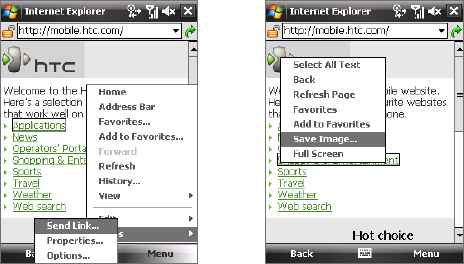
Getting Connected 157
Tap Menu > Tools and choose to send
the current Web page link, view the
page’s properties, or set preferences.
To save an image from a Web
page to your device, tap and hold
the image then tap Save Image.
Note: For more information about using Internet Explorer® Mobile, please go to:
http://www.microsoft.com/windowsmobile/help/pocketpc/browseinternet.mspx
10.9 Windows Live™
Windows Live™ gives you a full Internet experience on your device.
Windows Live helps you to find information, pursue your interests, and get
in touch with friends and family on the Internet easier.
Windows Live™ offers the following key features:
• Live Search Bar, which lets you search for information on the Web.
• Live Messenger, the next generation of MSN Messenger Mobile.
• Live Mail, the next generation of Hotmail.
• Live Contacts, your address book for storing Live Mail, Live
Messenger and Hotmail contacts.
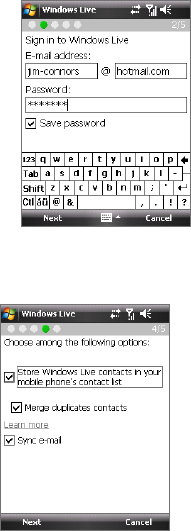
158 Getting Connected
Set up Windows Live™
The first time you use Windows Live™, sign in by using your Windows Live
ID, which is your Windows Live Mail or Hotmail address, and password.
To set up Windows Live for the first time
1. Tap Start > Programs > Windows Live.
2. Tap Sign in to Windows Live.
3. On the next screen, tap the links to read
the Windows Live™ Term of Use and
the Microsoft Privacy Statement. After
reviewing them, tap Accept.
4. Enter your Windows Live™ Mail or
Hotmail address and password, select the
Save password checkbox, then tap Next.
5. Choose whether or not to show
the Windows Live™ search bar and
applications on the Today screen then tap
Next.
6. Choose what information you want to sync online with your device.
If you select Store Windows Live
contacts in your mobile phone’s
contact list, your Windows Live
contacts will be added to the
contact list and to Live Messenger
on your device.
If you select Sync e-mail, your
Windows Live Mail or Hotmail inbox
messages will be downloaded to
your device.
7. Tap Next.
8. After synchronization is complete,
tap Done.
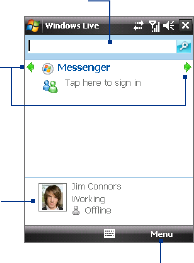
Getting Connected 159
The Windows Live™ interface
On the main interface of Windows Live™, you will see a search bar,
navigation bar, and an area where you can customize to show your picture.
1Live Search Bar
2Tap the Left or Right arrow to switch
between Windows Live Messenger,
Live Mail, and Sync status.
3Tap to change the display name,
picture, or personal message.
4Tap Menu to access and change
settings.
1
2
3
4
Tip If you chose to display the search bar and Windows Live™ applications on the
Today screen when you were setting up Windows Live, you’ll also see them
on the Today screen. To show or hide them from the Today screen, open
Windows Live and tap Menu > Options > Today screen options.
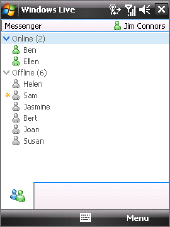
160 Getting Connected
Windows Live Messenger
With this mobile version of Windows Live Messenger, you enjoy many of
the same cool features that you get from the desktop version, which include
the following:
• Instant messaging via text and voice
• Multiple conversations
• Add emoticons
• Contact list with presence
• Send and receive files including
photos
• Change status/display name
• View contacts by online status,
groups, and more
• Send messages even when a contact
is offline
Note Before you can use Windows Live Messenger, your device must be connected
to the Internet. For information about setting up an Internet connection, see
“Ways of Connecting to the Internet” in this chapter.
Launch Messenger and sign in
To open Windows Live Messenger
Do one of the following:
• Tap Start > Programs > Messenger.
• On Windows Live™ or the Today screen, tap the Left or Right arrow
until you see Messenger, then tap it.
To sign in and out
1. Tap Sign in on the messenger screen.
2. If this is your first time to sign in, a message appears to inform you
that your messenger contacts will be added to the contact list on your
device. Tap OK to add them.
Signing in may take several minutes, depending on your connection
speed.
3. To sign out, tap Menu > Sign Out.
Getting Connected 161
To start and end conversations
1. In the contact list, select a contact then tap Send IM to open a
message screen.
2. Enter your text message in the text entry area of the message screen.
3. To add an emoticon, tap Menu > Add emoticon then tap an icon
from the list of emoticons.
4. Tap Send.
5. To end a conversation with the current contact, tap Menu > End
conversation.
Tips • To send a file, tap Menu > Send. You can choose to send a picture, voice
clip or any file.
• To invite one or more contacts to the conversation, tap Menu > Options >
Add participant.
• To send a voice message, tap Voice Clip on a message screen then start
talking. After you have recorded a message, tap Send.
Add Windows Live contacts
You can add new Windows Live contacts in Live Messenger or in Contacts.
To add a Windows Live contact in Live Messenger
1. Tap Menu > Add new contact.
2. Enter the e-mail address of the contact, then tap OK.
To add a Windows Live contact in Contacts
1. Tap Start > Contacts.
2. Tap New then tap Windows Live.
3. In the IM box, enter the e-mail address of the contact, which can be a
Windows Live ID or any other e-mail address.
Tip You can fill in other information about the contact, if desired. This is
not absolutely necessary if you will communicate with the contact only
through Windows Live Messenger or Live Mail.
4. Tap OK.
5. Follow the remaining instructions to add the new contact to your
Windows Live contact list.
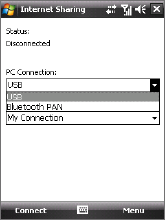
162 Getting Connected
10.10 Using Your Device as a Modem
(Internet Sharing)
Internet Sharing connects your PC or notebook computer to the Internet
by using your device’s data connection (GPRS or EDGE, for instance). You
can choose to connect via USB or Bluetooth.
Notes • Make sure your device has a SIM card installed, and your device has a
GPRS or phone dial-up modem connection. If your device has not been
set up with a data connection yet, tap Menu > Connection Settings on
the Internet Sharing screen. For more information about setting up these
connections, see "GPRS/3G" and "Dial-up" in this chapter.
• If you want to use a USB cable connection, you must first install Windows
Mobile Device Center or Microsoft ActiveSync version 4.5 or later on the
computer.
• If want to use a Bluetooth connection, make sure your computer has built-
in Bluetooth capability. If your computer does not have Bluetooth, you
can connect and use a Bluetooth adapter or dongle on your computer.
• Before using Internet Sharing, disconnect from Windows Mobile Device
Center or ActiveSync on your computer.
• On your computer, run 3gnetopt.exe from the Application Disc to
optimize the connection speed between your device and computer.
To set up your device as a USB modem
1. On your device, tap Start > Programs >
Internet Sharing.
2. In the PC Connection list, select USB.
3. In the Network Connection list, select
the name of the connection that your
device uses to connect to the Internet.
4. Plug in the USB cable between your
device and the computer.
5. Tap Connect.
Getting Connected 163
To use your device as a Bluetooth modem
For the computer to use the Internet connection of your device, activate
Internet Sharing on your device, then set up a Bluetooth Personal Area
Network (PAN) between the computer and your device.
1. On your device, turn on Bluetooth and set it to visible mode by
following the steps in “To turn Bluetooth on and make your device
visible”.
2. Initiate a Bluetooth partnership from your device by following the
steps in “To create a Bluetooth partnership.“
3. Tap Start > Programs > Internet Sharing.
4. Select Bluetooth PAN as the PC Connection.
5. From the Network Connection list, select the name of the
connection that your device uses to connect to the Internet.
6. Tap Connect.
7. On your computer, set up a Bluetooth Personal Area Network (PAN)
with your device:
For Windows Vista®:
a. Click Start > Control Panel > Network and Internet > Network
and Sharing Center.
b. Click Manage network connections and then under Personal
Area Network, double-click Bluetooth Network Connection.
c. In the Bluetooth Personal Area Network Devices dialog box, select
your device, then click Connect.
For Windows XP:
a. Tap Start > Control Panel > Network Connections.
b. Under Personal Area Network, click the Bluetooth Network
Connection icon.
c. Under Network Tasks, click View Bluetooth network devices.
d. In the Bluetooth Personal Area Network Devices dialog box, select
your device, then click Connect.
164 Getting Connected
Note If the Bluetooth adapter or dongle on your computer was installed
using a third-party provided driver, open the Bluetooth software that
came with the Bluetooth adapter/dongle to connect your computer
and device via Bluetooth. Refer to the Bluetooth adapter/dongle
documentation for more information.
8. On the Internet Sharing screen on your device, check if a connected
status message is displayed, which indicates that your computer has
been successfully connected to the Internet using your device as a
Bluetooth modem.
To end the Internet connection
• On the Internet Sharing screen, tap Disconnect.
10.11 Bluetooth
Bluetooth is a short-range wireless communications technology. Devices
with Bluetooth capabilities can exchange information over a distance of
about eight meters without requiring a physical connection.
Bluetooth modes
Bluetooth on your device operates in three different modes:
• On. Bluetooth is turned on. Your device can detect other Bluetooth-
enabled devices, but not vice versa.
• Off. Bluetooth is turned off. In this mode, you can neither send nor
receive information using Bluetooth. Turn off Bluetooth when not in
use to conserve battery power, or in places where using a wireless
device is prohibited, such as on board aircraft and in hospitals.
• Visible. Bluetooth is turned on, and all other Bluetooth-enabled
devices can detect your device.
Note By default, Bluetooth is turned off. If you turn it on, then turn off your device,
Bluetooth also turns off. When you turn on your device again, Bluetooth
automatically turns on.
Getting Connected 165
To turn Bluetooth on and make your device visible
1. On your device, tap Start > Settings > Connections tab > Bluetooth
> Mode tab.
2. Select the Turn on Bluetooth and Make this device visible to other
devices check boxes.
3. Tap OK.
Bluetooth partnerships
A Bluetooth partnership is a relationship that you create between your
device and another Bluetooth-enabled device in order to exchange
information in a secure manner.
To create a Bluetooth partnership
1. On your device, tap Start > Settings > Connections tab > Bluetooth.
2. On the Devices tab, tap Add new device. Your device displays the
names of other Bluetooth devices within range.
3. Tap the desired device name in the box, then tap Next.
4. Specify a passcode to establish a secure connection. The passcode
can be 1 up to 16 characters.
5. Tap Next.
6. Wait for the paired device to accept the partnership. The receiving
party needs to enter the same passcode that you specified.
7. The name of the paired device is then displayed. You may edit and
enter a new name for that device.
8. Select the check boxes of services that you want to use from the
paired device.
9. Tap Finish.
Note Creating a Bluetooth partnership between two devices is a one-time process.
Once a partnership is created, the devices can recognize the partnership and
exchange information without entering a passcode again.
166 Getting Connected
To accept a Bluetooth partnership
1. Ensure that Bluetooth is turned on and in visible mode.
2. Tap Yes when prompted to establish a partnership with the other
device.
3. Enter a passcode (the same passcode that is entered on the device
requesting the partnership) to establish a secure connection. The
passcode must be between 1 and 16 characters.
4. Tap Next.
5. Tap Finish. You can now exchange information with the paired
device.
Tips • To rename a Bluetooth partnership, tap and hold the partnership’s name
on the Devices tab of the Bluetooth Settings screen, then tap Edit.
• To delete a Bluetooth partnership, tap and hold the partnership’s name on
the Devices tab, then tap Delete.
Connect a Bluetooth hands-free or stereo headset
For hands-free phone conversations, you can use a Bluetooth hands-free
headset such as a car kit with your device. Your device also supports A2DP
(Advanced Audio Distribution Profile) which allows you to use a Bluetooth
stereo headset for hands-free phone conversations and for listening to
stereo music.
To connect a Bluetooth hands-free or stereo headset
1. Make sure that both your device and the Bluetooth headset are
turned on and within close range, and that the headset is visible.
Refer to the manufacturer’s documentation to find out how to set the
headset in visible mode.
2. Tap Start > Settings > Connections tab.
3. Tap Bluetooth > Devices tab > Add new device. Your device displays
the names of other Bluetooth devices within range.
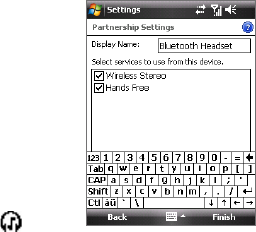
Getting Connected 167
4. Tap the name of the Bluetooth headset,
then tap Next.
5. Enter the passcode of the Bluetooth
headset, then tap Next.
6. Make sure the Hands Free check box is
selected. If you have a Bluetooth stereo
headset, also make sure Wireless Stereo
is selected.
7. Tap Finish.
While the Bluetooth stereo headset is
connected, the Headset icon ( ) will
appear on the title bar.
Note If the Bluetooth stereo headset becomes disconnected, turn the headset on
and repeat steps 1 to 3 above. Tap and hold the name of the Bluetooth stereo
headset and tap Set as Wireless Stereo.
Beam information using Bluetooth
You can beam information, such as contacts, calendar items, and tasks, as
well as files from your device to your computer or to another Bluetooth-
enabled device.
Note If your computer does not have built-in Bluetooth capability, you need to
connect and use a Bluetooth adapter or dongle on your computer.
To beam information from your device to a computer
1. Turn on Bluetooth on your device, and make your device visible. For
information about this, see “To turn Bluetooth on and make your
device visible”.
2. Set Bluetooth on your computer to visible mode, create a Bluetooth
partnership, then enable your computer to receive Bluetooth beams.
Note If the Bluetooth adapter or dongle on your computer was installed
using a third-party provided driver, open the Bluetooth software that
came with the Bluetooth adapter/dongle and enable the adapter/
dongle to be discovered by other devices. Refer to the Bluetooth
adapter’s documentation for more information.

168 Getting Connected
If your computer has Windows Vista® or Windows XP SP2 and your
computer’s Bluetooth adapter is supported by your Windows version,
do the following steps:
a. On your computer, open Bluetooth Devices from the Control
Panel then click the Options tab on the Bluetooth Devices
window.
b. For Windows Vista, select Allow Bluetooth devices to find this
computer.
For Windows XP, select Turn discovery on and Allow Bluetooth
devices to connect to this computer.
c. Create a Bluetooth partnership between your device and
computer. For information about creating a partnership, see
“Bluetooth partnerships”.
d. In the Options tab of Bluetooth Devices, select Show the
Bluetooth icon in the notification area.
e. To enable your computer to receive Bluetooth beams, right-click
the Bluetooth icon in the notification area at the bottom-right
of your computer screen and select Receive a File.
3. Now you are ready to beam. On your device, select an item to beam.
The item can be an appointment in your calendar, a task, a contact
card, or a file.
4. To beam a contact, tap Menu > Send Contact > Beam.
To beam other types of information, tap Menu > Beam [type of
item].
5. Tap the device name to which you want to send the item.
6. If you beamed a calendar, task, or contact item to your computer and
it is not automatically added to Outlook, select File > Import and
Export in Outlook to import it.
To beam information to a Bluetooth-enabled device such as another
Windows Mobile powered device, follow steps 1 to 5 in the above
procedure.
Tips • The default folder on your computer where beamed items are stored
may be C:\Documents and Settings\your_username\My Documents in
Windows XP or C:\Users\your_username\My Documents in Windows Vista.
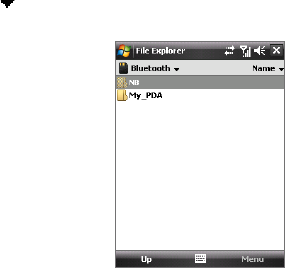
Getting Connected 169
• For your device to receive Bluetooth beams, tap Start > Settings >
Connections tab > Beam and make sure the Receive all incoming
beams check box is selected.
Bluetooth Explorer and Bluetooth file sharing
Bluetooth Explorer searches for other Bluetooth devices that have file
sharing enabled and lets you access their Bluetooth shared folder. You
can copy files from and to their shared folder, and create subfolders in it.
When you enable Bluetooth file sharing on your device, other Bluetooth-
enabled devices will also be able to access your Bluetooth shared folder.
To enable Bluetooth Explorer and Bluetooth file sharing on your device
1. Tap Start > Settings > Connections tab > Bluetooth > FTP tab.
2. Select the Enable Bluetooth Explorer check box. This makes the
\Bluetooth device folder visible in the File Explorer.
3. Select the Enable File Sharing check box.
You can use the default Bluetooth shared folder, or tap Browse to use
another folder as your shared folder.
4. Tap OK.
To use Bluetooth Explorer
1. Bluetooth Explorer is integrated with the File Explorer program. You
can open it by tapping Start > Programs > Bluetooth Explorer or
by tapping Down arrow ( ) on the upper left of File Explorer then
tapping Bluetooth.
2. Bluetooth Explorer then scans for other
Bluetooth devices that have file sharing
enabled. From the list, tap to select a
Bluetooth device you want to connect
to. You may need to enter a passcode in
order for you to connect to the selected
device.
If there are files contained in the
Bluetooth shared folder on the other
device, you will be able to see them on
the Bluetooth Explorer screen.
170 Getting Connected
3. Select one or more files, then tap Menu > Edit and choose to cut or
copy the files.
4. Tap Up twice.
5. Navigate to the folder where you want to paste the files on your
device, then tap Menu > Edit > Paste.
Print files via Bluetooth
Connect your device to a Bluetooth printer to print contact information,
appointment details, messages, and other file types.
Note You can print files in the .txt, .jpg, .xhtml, .vcf, .vcs file formats.
Before you start printing, make sure to turn on the Bluetooth printer and
to turn on Bluetooth on your device. To turn on Bluetooth, tap Start >
Programs > Comm Manager and then tap the Bluetooth button.
To print contact information
1. Tap Start > Contacts and then select the contact whose information
you want to print.
2. Tap Menu > Print via Bluetooth.
3. Tap Menu > Search Device. Your device starts to search for Bluetooth
devices.
4. Select the Bluetooth printer and tap Menu > Send File.
5. Set the printing options you want and then tap Print.
To print a calendar appointment
1. Tap Start > Calendar and then select the appointment whose details
you want to print.
2. Follow steps 2 to 5 in the “To print contact information” procedure.
To print a message
1. Tap Start > Messaging and then select the messaging account where
the message you want to print is located.
2. Select the message you want to print.
3. Follow steps 2 to 5 in the “To print contact information” procedure.
Getting Connected 171
To print a JPEG file
1. Do one of the following:
• In Pictures & Videos, select the JPEG file and then tap Menu > Print
via Bluetooth.
• In File Explorer, tap and hold the JPEG file and then on the menu, tap
Print via Bluetooth.
2. Follow steps 3 to 5 in the “To print contact information” procedure:
172 Getting Connected

Chapter 11
Using GPS
11.1 Guidelines and Preparation
for Using GPS
11.2 Downloading Satellite Data
via QuickGPS
11.3 GPS Controls
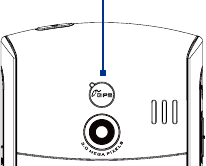
174 Using GPS
11.1 Guidelines and Preparation for Using GPS
•Do not operate the GPS system while driving. The plotted GPS route
is only for driving reference. It should not interfere with actual driving
behavior.
•Please use the GPS system cautiously. Users shall be liable for any
damages resulting from negligent operation of the system.
• The GPS signal cannot pass
through solid non-transparent
objects. Signal reception may be
affected by obstructions such
as high-rise buildings, tunnels,
bridges, forests, weather (rainy or
cloudy days), etc. If the vehicle’s
visor contains metal, it will be
difficult for the GPS signal to
pass through. For better signal
reception, connect your device to
an external GPS antenna.
External GPS
antenna connector
• Wireless communication products (such as mobile phones or radar-
detecting devices) may interfere with the satellite signal, resulting in
unstable signal reception.
• The Global Positioning System (GPS) is built and operated by the US
Defense Department. The Department is responsible for the accuracy
and maintenance of the system. Any changes that the Department
makes may affect the accuracy and function of the GPS system.
• Do not leave your device in a vehicle or expose the device to direct
sunlight to avoid overheating the battery, which could pose damage
to the device or risk to the vehicle.
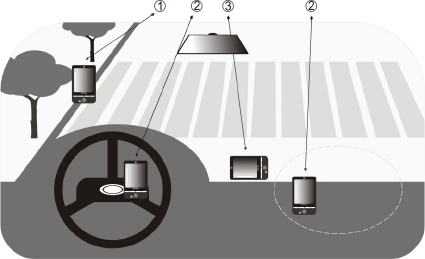
Using GPS 175
•When using the device inside a vehicle, use the car holder to mount
the device securely in place. Avoid placing the device in the areas
shown in the following diagram:
1 Do not place where it will block the driver’s vision.
2 Do not place where air bags could deploy.
3 Do not place anywhere in the vehicle without securing the device
in the holder.
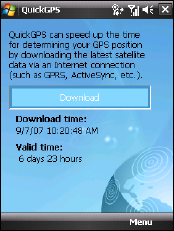
176 Using GPS
11.2 Downloading Satellite Data via QuickGPS
Before you start to use your device for GPS navigation, open the QuickGPS
program first to download ephemeris data (current satellite position and
timing information) onto your device. This data is needed to determine the
GPS position of your current location.
QuickGPS downloads ephemeris data from a Web server, instead of from
the satellites, using the Internet connection on your device, which can
be via ActiveSync or 3G/GPRS. This significantly speeds up the time for
determining your GPS position.
To open QuickGPS
Tap Start > Programs > QuickGPS.
To download data
Tap Download on the QuickGPS screen.
On the screen, initially, you will see the Valid
time of the downloaded data. As time passes,
the remaining days and hours of validity will
be shown.
To speed up GPS positioning, download the
latest ephemeris data when the validity of the
data expires.
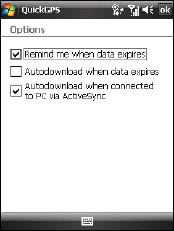
Using GPS 177
Download options
To configure download times, tap Menu > Options and choose from the
available options:
• Remind me when data expires.
Enables your device to display a
reminder message when the validity of
the ephemeris data has expired.
When you see the reminder message,
tap Menu to dismiss the reminder or
to set the snooze time so that you will
be reminded again. Tap OK to open the
QuickGPS program and download the
latest data.
• Autodownload when data expires.
Allows ephemeris data to be
automatically updated onto your device
when the data has expired.
• Autodownload when connected to PC via ActiveSync.
Allows ephemeris data to be automatically downloaded via
ActiveSync to your device when your device is connected to your
computer. Your computer must be connected to the Internet in order
to download data.
Note The ephemeris data is stored on HTC Web servers. QuickGPS is
preconfigured to connect to these servers.
178 Using GPS
11.3 GPS Controls
When a map or menu is shown on the GPS software, use the following
controls on your device to navigate:
• On the Map Browser screen, press NAVIGATION up to zoom in, press
NAVIGATION down to zoom out on a map.
• Use the NAVIGATION CONTROL to scroll through items in a menu.
Press the ENTER button to select a menu item and open the
corresponding screen.
Tip You can also rotate the NAVIGATION WHEEL to select items in a menu and to
zoom in and out on the Map Browser screen.

Chapter 12
Experiencing Multimedia
12.1 Camera
12.2 Camera Album
12.3 Pictures & Videos
12.4 Windows Media® Player Mobile
12.5 Streaming Media
12.6 Audio Manager
12.7 Using Audio Booster
12.8 Using FM Radio
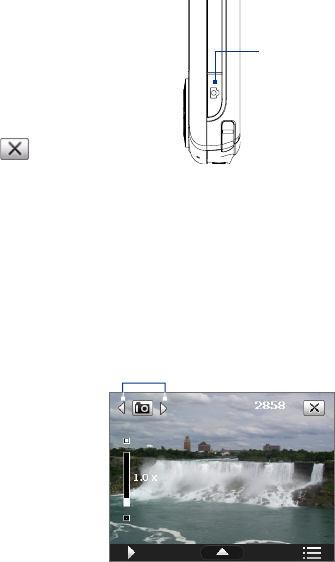
12.1 Camera
Taking photos and recording video clips along with audio are easy with
your device’s two built-in cameras:
Main camera: Rear 3 megapixel CMOS camera for capturing high resolution
pictures and video clips with audio
2nd camera: Front camera for video calls and taking self-portrait shots
To open the Camera screen
• Press the CAMERA button on your device.
• Tap Start > Programs > Camera.
The screen orientation automatically switches to
landscape mode when you open Camera.
To exit the Camera
• Tap the Exit icon ( ) on the Camera
screen.
CAMERA
button
Capture modes
The camera on your device allows you to capture pictures and video clips by
using various built-in modes that provide you flexibility in taking your shots.
The Camera mode is set to the Photo capture mode by default. The upper
left corner of the screen displays the active capture mode.
To change the capture mode
• Tap the left or right arrows
next to the mode icon.
• Press NAVIGATION right or
left (in landscape orientation).
Tap to change the capture mode.
180 Experiencing Multimedia
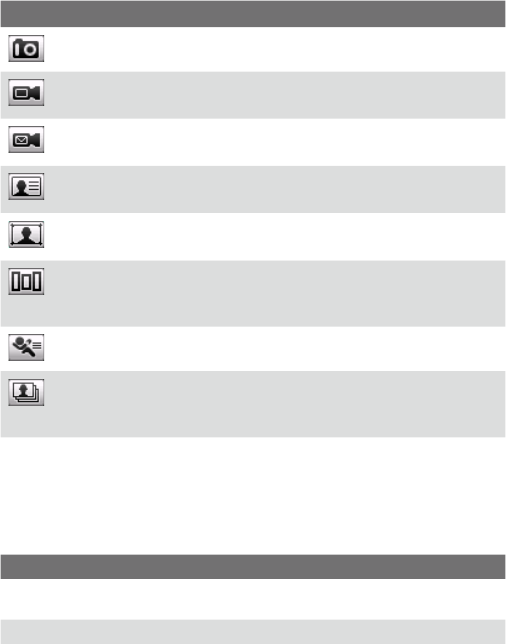
You can select from the following capture modes:
Icon Capture Mode
Photo: Captures standard still images.
Video: Captures video clips, with or without accompanying
audio.
MMS Video: Captures video clips suitable for sending with MMS
messages.
Contacts Picture: Captures a still image and gives you the
option to immediately assign it as a Photo ID for a contact.
Picture Theme: Captures still images and places them within
frames.
Panorama: Captures a sequence of still images continuously
in one direction, and stitches the images to create a panoramic
view of a scene.
Sports: Captures consecutive photo shots (3, 5, 7, or 10).
Burst: Captures a sequence of still images (maximum 30) as long
as the CAMERA button on the device or the ENTER button on the
NAVIGATION CONTROL is kept pressed.
Note When using the 2nd camera to capture, you can only use Photo, Video, MMS
Video, Contacts Picture, and Picture Theme modes.
File formats supported
Using the available capture modes, the camera in your device captures files
in the following formats:
Capture type Format
Still image / Contacts Picture /
Panorama / Sports / Burst
JPEG
Video / MMS Video H.263 (.3gp) ; MPEG-4 (.mp4)
Experiencing Multimedia 181
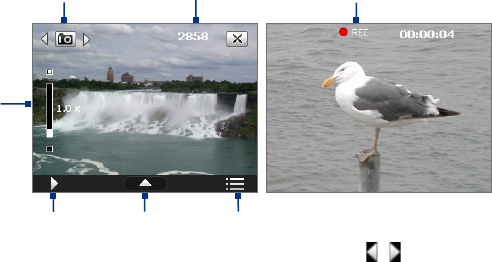
182 Experiencing Multimedia
Camera controls
• Press CAMERA or ENTER to take a photo or contacts picture.
• Press CAMERA or ENTER to start recording video; press it again to stop
recording.
• Press CAMERA or ENTER each time when taking photos for a picture
theme or panorama.
• To take consecutive shots in Sports mode, press CAMERA or ENTER,
then move your device to follow the movement of your subject.
• Press and hold the CAMERA button or the ENTER button when taking
consecutive shots in Burst mode. Release the button to stop taking
shots.
On-screen controls and indicators
The on-screen controls and indicators disappear after about 3 seconds. To
make the controls and indicators reappear, touch or tap the screen.
3
7
Video mode
6
1 2
4
Photo mode
5
1 Mode Switching control. Tap the left/right arrow ( / ) on the
screen to switch the capture mode.
2 Remaining information indicator. In Photo, Contacts Picture, Picture
Theme, Panorama, Sports, and Burst modes, this shows the remaining,
available shots of pictures based on current settings.

Experiencing Multimedia 183
In Video and MMS Video modes, this shows the remaining duration
that can be recorded. While recording video, this shows the recorded
duration.
3 Zoom control. Tapping / on the screen allows you to zoom in or
zoom out.
Note This control only appears when zooming is supported by the
Resolution you have selected.
Tip You can also press NAVIGATION up/down or rotate the NAVIGATION
WHEEL to zoom in an out.
4 Album. Tap to open Camera Album. See “Camera Album” for details.
5 Quick Settings Panel. Tap to open the Quick Settings Panel. See
“Quick Settings Panel” for details.
6 Menu. Tap to open the Camera Settings screen.
7 Recording indicator. This shows a red, flashing indicator while video
recording is in progress.
Picture Theme mode
8
10
Sports mode
9
8
Template Selector icon. In Picture Theme mode, tap to toggle
among the different templates.
9
Progress indicator. In Picture Theme, Panorama, Sports, and Burst
modes, this shows the number of consecutive shots.
10 Exit. Tap to exit the Camera program.
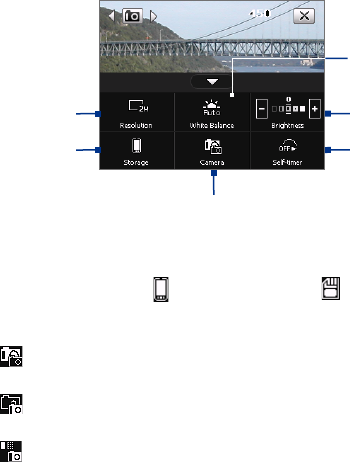
184 Experiencing Multimedia
Quick Settings Panel
The Quick Settings Panel provides a quick way of adjusting the most
common camera settings. Tap the screen to open the Quick Settings Panel.
Keep tapping a button on the panel, for instance, Resolution, to cycle
through the available settings.
Note The available settings on the menu depend on the Capture mode selected.
2
15
4
3
6
1 Resolution. Tap to change the resolution. See the table in the
previous page for the detailed capture sizes.
2 Storage. Tap to toggle between saving captured photos or video clips
on the device memory or on the storage card .
3 Camera. The camera icon indicates the current camera being used.
Tap to cycle through the different cameras.
Main Camera: 3 megapixel CMOS camera that is at the back
panel of the device, used for taking standard pictures and videos.
2nd Camera: Camera at the upper right corner of the front panel
of the device, used for shooting self-portrait pictures and videos.
2nd Camera (Flip): Used for taking self-portrait pictures and
videos without mirroring.
If there is text on your self-portrait shot (for example, if you’re wearing
a shirt with text), the text appears inverted on the captured image/
video in 2nd Camera mode. Use 2nd Camera (Flip) mode to invert the
self-portrait so that the text is readable on the captured image/video.
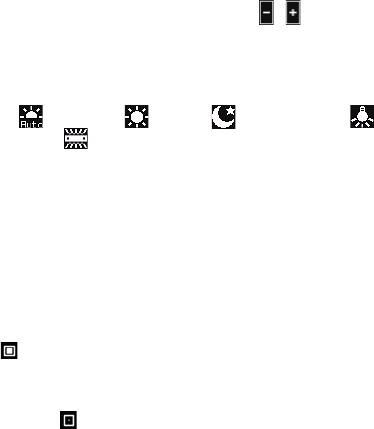
Experiencing Multimedia 185
4 Self-timer. Tap to set the self-timer to 2 seconds, 10 seconds, or Off
when in the Photo or Contacts Picture mode. When you press the
CAMERA or ENTER button to capture a still image, it starts to count
down, and then captures a still image after the assigned time.
5 Brightness. Tapping the minus/plus icon ( / ) decreases or
increases the brightness level.
6 White Balance. White balance enables the camera to capture colors
more accurately in different lighting conditions. White balance
settings include:
Auto ( ), Daylight ( ), Night ( ), Incandescent ( ), and
Fluorescent ( ).
Zooming
Before capturing a still image or a video clip, you can zoom in to make the
object in focus move closer or zoom out to make the object move farther
away.
Note The zoom control only appears onscreen when zooming is supported by the
Resolution you have selected.
To zoom in
• Rotate the NAVIGATION WHEEL clockwise, press NAVIGATION up, or
tap .
To zoom out
• Rotate the NAVIGATION WHEEL counterclockwise, press NAVIGATION
down or tap .
The camera zoom range for a picture or a video clip depends on the capture
mode and capture size. The following table is a summary.
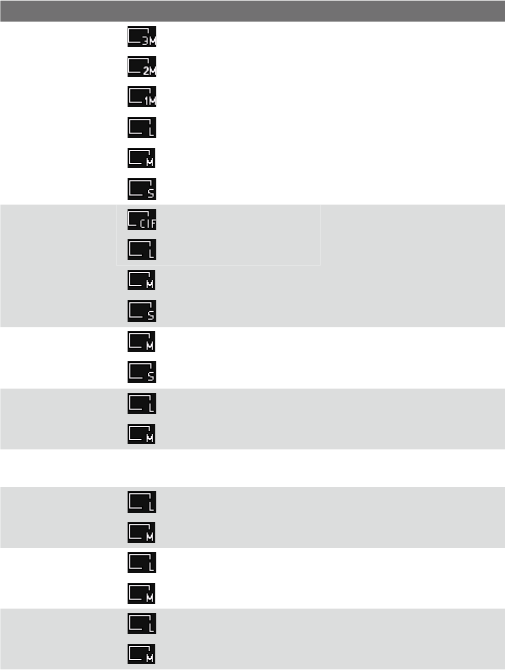
186 Experiencing Multimedia
Capture mode Capture size setting Zoom range
Photo
3M (2048 x 1536) No zooming available
2M (1600 x 1200) No zooming available
1M (1280 x 960) 1.0x to 2.0x
Large (640 x 480) 1.0x to 2.0x
Medium (320 x 240) 1.0x to 4.0x
Small (160 x 120) 1.0x to 8.0x
Video
CIF (352 x 288) 1x and 2x
Large (320 x 240) 1x and 2x
Medium (176 x 144) 1x and 2x
Small (128 x 96) 1x and 2x
MMS Video Medium (176 x 144) 1x and 2x
Small (128 x 96) 1x and 2x
Contacts
Picture
Large (480 x 640) 1.0x to 2.0x
Medium (240 x 320) 1.0x to 4.0x
Picture Theme Determined by the current
template
Depends on the size of the
template currently loaded
Panorama Large (640 x 480) 1x and 2x
Medium (320 x 240) 1x, 2x and 4x
Sports Large (640 x 480) 1x and 2x
Medium (320 x 240) 1x, 2x and 4x
Burst Large (640 x 480) 1x and 2x
Medium (320 x 240) 1x, 2x and 4x
For capture size settings and zoom ranges when using the 2nd camera,
please refer to the online help.
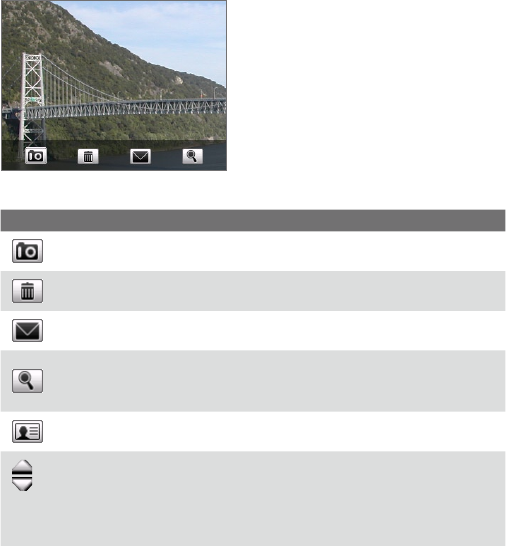
Experiencing Multimedia 187
The Review screen
After taking a still image or
recording a video clip, you can view,
send, or delete the image or video
clip on the Review screen.
You can also tap the following icons at the bottom of the Review screen:
Icon Function
Back Return to the live Camera screen.
Delete Remove the captured image or video.
Send Send via e-mail or MMS.
View
View the image in the Camera Album program,
or play the captured video in Windows Media®
Player.
Assign to Contacts Associate the photo to a selected contact.
Browse
After capturing in Sports or Burst mode, the total
number of consecutive shots is shown in the
top right corner of the Review screen. Tap the
up/down arrow to browse through the sequence
of photos.
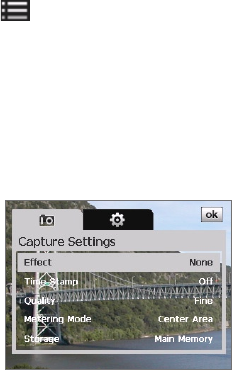
188 Experiencing Multimedia
Camera settings
Tap the Menu icon ( ) to open the Camera Settings screen. The Camera
Settings screen allows you to configure capture and camera settings.
The Camera settings consist of two tabs: Capture Settings and Advanced.
Use the Capture Settings tab to adjust options for your selected capture
mode; Use the Advanced tab to set the Camera program preferences.
You can either tap on-screen or press the Navigation Control buttons to
navigate the Camera Settings screen.
Capture Settings tab
The available options in this tab depend on the capture mode selected.
• Effect. Choose a special effect such as Grayscale, Sepia, etc., to
apply to your photos or video clips.
• Time Stamp (Photo, Sports and Burst modes). Choose whether or
not to include the shooting date and time on captured photos.
• Template (Picture Theme mode). Select a template.
• Capture Speed (Burst and Sports modes). This determines the
interval between shots. Fast captures consecutive shots at the
shortest interval.
• Snapshots (Sports mode). Select the number of consecutive shots
to capture.
• Direction (Panorama mode). Choose in what direction images will
be stitched in a panorama.
• Stitch Count (Panorama mode). Select the number of snapshots
to be taken and stitched into a panorama.

Experiencing Multimedia 189
• Quality. Select the JPEG image quality level for all captured still
images. Choose from Basic, Normal, Fine, and Super Fine.
• Metering Mode. Select a metering mode to allow the camera to
measure the amount of light and calculate the best-fit exposure
value before capturing. Choose either Center Area to measure
light using the center area of the image or Average to measure
light using the area all around the image.
• Storage. Select where you want to save your files. You can either
save the files to the main memory or to a storage card.
Advanced tab
The available options in this tab depend on the capture mode selected.
• Capture Format. Select the
desired file format.
• Shutter Sound. Choose whether
or not you want the camera to
make a shutter sound when you
press the ENTER or CAMERA
button.
• Shoot Option. The camera comes with an auto-focus feature
that is activated when the CAMERA or ENTER button is pressed.
Selecting Full Press requires you to press the CAMERA button all
the way to take the shot after auto-focus is set. Selecting Half Press
automatically takes the shot after auto-focus is set.
Note This option only applies to the CAMERA button. Pressing the ENTER
button automatically takes the shot.
• Grid (Photo mode).
Choose whether or not
to show a grid on the
Camera screen. Showing a
grid helps you frame and
center your subject more
easily and accurately.
Grid
marks
190 Experiencing Multimedia
• Keep Backlight. Turn the backlight on or off. This overrides your
device backlight settings while you are using the camera.
• Review Duration. Set a time length for displaying the captured
image/video on the Review screen. Select No Limit if you do not want
to impose a time limit. Select No Review to immediately return to the
live Camera screen after capturing and saving.
• Flicker Adjustment. When taking indoor shots, flicker on the camera
screen may be caused by inconsistencies between the vertical scan
rate of the camera display and the flicker frequency of fluorescent
lighting. To reduce flicker, you can change the flicker adjustment
setting to Auto or to the proper frequency (50Hz or 60Hz) of the
power in the country where your device is being used.
• Record with Audio (Video and MMS Video mode). Select On to
record audio with the captured video clips, or select Off to capture
video without audio.
• Prefix. When Default is selected as the prefix, the file name of each
new captured file is set to “IMAGE” or “VIDEO” followed by a sequential
number, for example: IMAGE_001.jpg. You may also choose to name
files using either the current Date or Date & Time as the prefix.
Note If you set the Camera to save captured photos to a storage card, the
prefix cannot be selected. Captured photos will be named using the
convention IMAGnnnn.jpg (where 'nnnn' is the counter) which is the
DCIM (Digital Camera Images) naming standard, and will be saved to
the \DCIM\100MEDIA folder on the storage card.
• Counter. To reset the file naming counter back to 1, tap Reset.
• Recording Limit (Video mode). Set the maximum duration or file size
for recording video.
• Template Folder (Picture Theme mode). By default, templates are
stored in the \My Documents\Templates folder on the device’s Main
Memory. If you transferred some templates to a storage card (via File
Explorer), set this option to Main + Card to specify that templates are
located in both the main memory and the storage card.
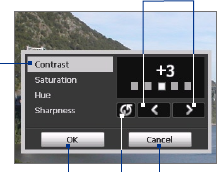
Experiencing Multimedia 191
• Image Properties. This option lets you adjust the camera display
properties, such as Contrast, Saturation, Hue, and Sharpness.
1Tap a property to adjust.
2Tap the left/right arrow icon
or press NAVIGATION left/right
(in landscape orientation) to
increase/decrease the value.
3Tap to close the submenu
without applying and saving the
changes.
4Tap to reset all properties to
their default values.
5Tap to save the settings.
2
3
4
1
5
• Show Reminder (Contacts Picture mode). Select On if you want the
Camera to always display a message that confirms whether or not to
assign the captured picture to a contact.
• Help. Tap to open the Camera program help file.
• About. Tap to view information about the Camera program.
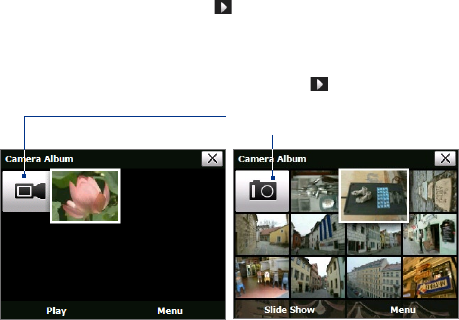
192 Experiencing Multimedia
12.2 Camera Album
Use the Camera Album to view images and videos that you captured using
the Camera program. Camera Album offers a host of features that let you
rotate images, view your images as a slide show, use images as contact
pictures, and more.
Note Only files supported by the Camera program are displayed in Camera Album.
To know which file formats are supported, see “File formats supported" in the
Camera section.
To open Camera Album
Do one of the following:
• Tap Start > Programs > Camera Album.
• In the Touch Cube, touch Photos or Videos.
• In the Camera program, tap . Depending on the capture mode you
are in, Camera Album will either show still images or video files in
your device. For example, if you are in Photo mode, only still images
will be shown in Camera Album. To view video files, switch first to
Video or MMS Video mode before tapping .
Touch to go to the Camera
program
Opened from a still image capture mode
Opened from a video capture mode
Tip If you have a lot of images in your device, scroll down by sliding your finger
upward. Scroll up by sliding your finger downward.
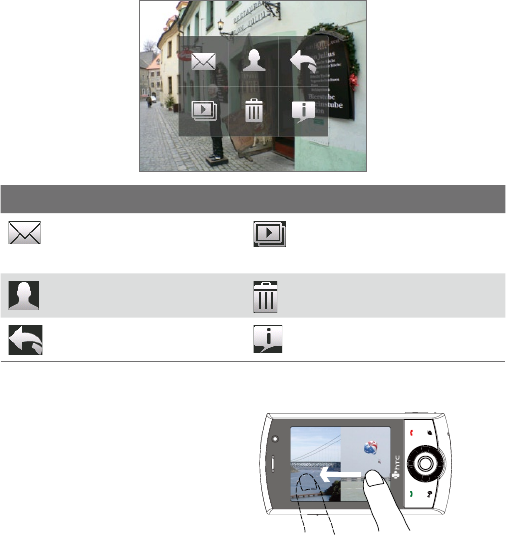
Experiencing Multimedia 193
To view an image
On the main Camera Album screen, touch the thumbnail of the image
you want to view. While viewing the image, you can zoom in or rotate the
image. To learn how to zoom and rotate the image, see the succeeding
procedures.
While viewing an image, touch the screen or press ENTER to open the on-
screen menu.
Icon Function Icon Function
Touch to send the image
via one of your Messaging
accounts.
Touch to start the slide show.
Touch to assign the image as
a contact picture.
Touch to delete the image.
Touch to return to the main
Camera Album screen.
Touch to show you how to use
gestures when viewing photos.
To go to the next image
Go to the next image by sliding your
finger across the screen from right
to left.
Go back to the previous image by
sliding your finger from left to right.
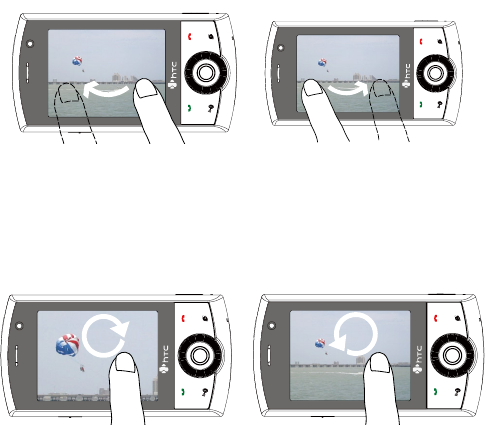
194 Experiencing Multimedia
To rotate the image
1. View the image you want to rotate.
2. With your finger, make a semicircle motion on the screen.
Slide your finger counter-clockwise to
rotate the image 90 degrees counter-
clockwise.
Slide your finger clockwise to rotate the
image 90 degrees clockwise.
To zoom in or out of an image
While viewing an image, make a full circle motion on the screen with your
finger.
Slide your finger clockwise on an area to
zoom in on that area.
Slide your finger counter-clockwise to
zoom out.
Tips • When you zoom in on an image, you can double tap the screen to
automatically zoom out and fit the image to the screen.
• When you zoom in on an image, touch and hold the screen so you can
pan the image.
• You can also zoom in and out of the image by rotating the NAVIGATION
WHEEL.
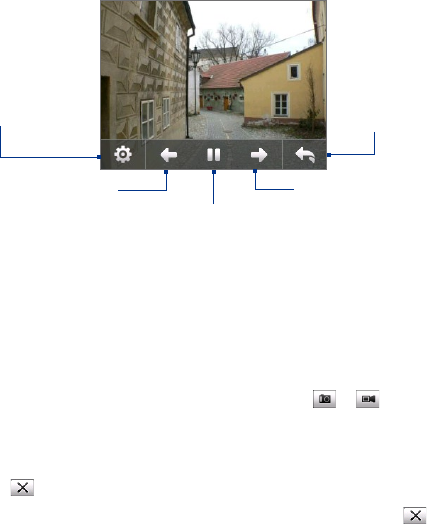
Experiencing Multimedia 195
To view the images as a slide show
On the Camera Album screen, touch Slide Show. While viewing the slide
show, touch the screen to show playback controls.
Touch to go back to
the previous image.
Touch to open the slide
show options where you
can set the transition
effect to use, time per
slide, and orientation of
the images.
Touch to return
to the main
Camera Album
screen.
Touch to play or pause
slideshow playback.
Touch to go to the next
image.
To play back video files
On the main Camera Album screen, touch the thumbnail of the video file
you want to play back. Windows Media Player then plays back the file.
Tip You can also select the video file and tap Play to play back the file in
Windows Media Player.
To close Camera Album and go to the Camera program
Go back to the main Camera Album screen and touch or .
To close Camera Album
When you open Camera Album from Start > Programs, you can close
Camera Album by going back to the main Camera Album screen and
tapping .
Note When you open Camera Album from the Camera program, tapping
takes you back to the Camera program.
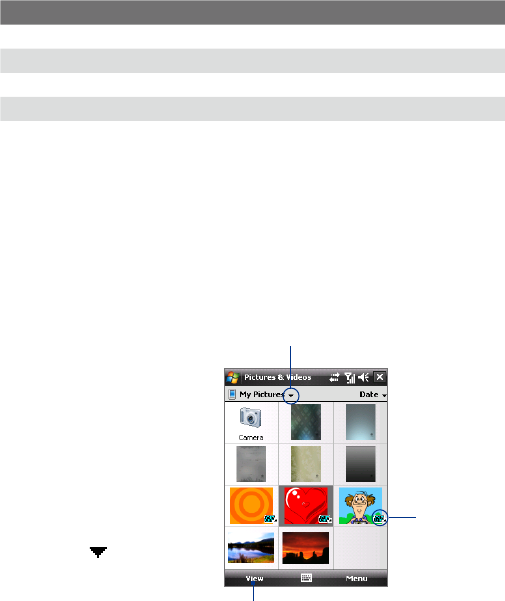
196 Experiencing Multimedia
12.3 Pictures & Videos
Pictures & Videos allows you to manage the following types of media files
on your device:
File Type File Extensions
Image *.bmp, *.jpg, *.gif, *.png
GIF animation *.gif
Video *.avi, *.wmv, *.mp4, *.3gp, *.3g2
Audio *.wma
To open Pictures & Videos
• Tap Start > Programs > Pictures & Videos.
To copy media files to your device
• Copy pictures and GIF animation files from your PC or a storage card
to the My Pictures folder on your device.
• Copy video files to the My Videos folder.
For more information about copying and managing files on your device, see
Chapter 9.
To view pictures
1. The images in the My
Pictures folder appear
as thumbnails by
default.
2. Select a picture and tap
View. If you cannot find
a picture in the default
My Pictures folder,
go to another folder
by tapping the Down
arrow ( ).
Down arrow
Tap to view the selected image.
GIF animation
icon
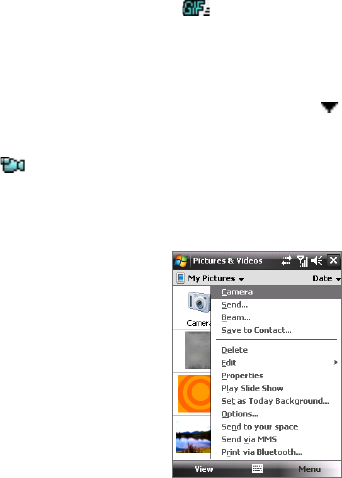
Experiencing Multimedia 197
To play GIF animation files
1. Select a GIF animation file (marked with a icon) and tap View.
2. The GIF Animation program then opens and plays the animation.
To play videos
1. By default, the contents of the My Pictures folder will be shown.
2. To find the video clips that you captured, tap the down arrow ( )
next to the My Pictures folder and tap My Documents > My Videos.
Video clips are displayed as thumbnails by default, which appear with
a media icon ( ).
3. Tap to select a video and play it in Windows Media® Player Mobile.
Pictures & Videos menu
Select a media file and then tap Menu to
choose from a list of options that you can
do with the selected media file.
You can send the selected media file via
one of your messaging accounts or beam
it to another device. If you selected a
picture, you can associate it to a contact,
set it as your Today screen background,
send it to your Windows Live Space
account, and more. You can also view the
images in the My Pictures folder as a slide
show.
Note The available menu options depend on
the selected media file.
To edit a picture
You can rotate, crop, and adjust the brightness and color contrast of your
pictures.
1. On the Pictures & Videos screen, tap the picture you want to edit.
2. Tap Menu > Edit, and do any of the following:
• To rotate a picture 90 degrees clockwise, tap Rotate.

198 Experiencing Multimedia
• To crop a picture, tap Menu > Crop. Next, tap and drag to select
the area to crop. Tap inside the box to crop, or tap outside the box
to cancel cropping.
• To adjust the brightness and contrast levels of a picture, tap Menu
> Auto Correct.
Note To undo an edit, tap Menu > Undo. To cancel all unsaved edits you
made to the picture, tap Revert to Saved.
12.4 Windows Media® Player Mobile
You can use Windows Media® Player Mobile to play digital audio and video
files that are stored on your device or on a network, such as on a Web site.
Video File Formats Supported File Extensions
Windows Media Video
MPEG4 Simple Profile
H.263
H.264
Motion JPEG
.wmv, .asf
.mp4
.3gp, .3g2
.mp4, .3gp, .3g2, .m4v
.avi
Audio File Formats Supported File Extensions
Windows Media Audio
WAV
MP3
MIDI
AMR Narrow Band
AMR Wide Band
AAC, AAC+ and eAAC+
MPEG4 audio
QCELP
.wma
.wav
.mp3
.mid, .midi, .rmi
.amr
.awb
.aac, .mp4, .m4a
.mp4, .m4a
.qcp
To open Windows Media® Player Mobile
• Tap Start > Programs > Windows Media.
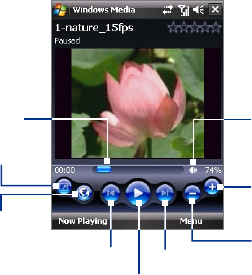
Experiencing Multimedia 199
About the controls
The following are available controls on the Windows Media® Player Mobile.
Play/Pause
Full screen
Visit WindowsMedia.com
Tap and drag to
jump to any part of
the video or audio
Skip to the beginning of
the current file or to the
previous file
Skip to the next file
Mute/Unmute
Increase Volume
Decrease Volume
About the screens and menus
Windows Media® Player Mobile has three primary screens:
• Playback screen. The screen that displays the playback controls (such
as Play, Pause, Next, Previous, and Volume) and the video window.
You can change the appearance of this screen by choosing a different
skin.
• Now Playing screen. The screen that displays the Now Playing
playlist. This special playlist indicates the current file being played and
any files that are “queued up” to play next.
• Library screen. The screen that lets you quickly find your audio files,
video files, and playlists. It contains categories such as My Music, My
Videos, My TV, and My Playlists.
At the bottom of each screen, you can open a Menu. The commands on
this menu vary, depending on which screen you are viewing. For more
information about the commands in these menus, see Help on your device.
200 Experiencing Multimedia
Synchronize video and audio files
Use the latest version of Windows Media® Player on your PC to synchronize
digital media files from your PC to your device. This ensures that protected
files and album art (for skins) are copied to your device correctly.
To synchronize content to your device automatically
1. On your PC, start Windows Media® Player and then connect your
device to your PC.
2. In the Device Setup Wizard, select Yes, search my computer now.
Note If you have previously opened Windows Media® Player and searched
for media on your computer, you will not be prompted to search your
computer in Step 2.
3. You will then see the name of your device (or “Storage Card” if you
have inserted one on your device). Click Finish.
4. On the left panel of Windows Media® Player, right-click the name of
your device then click Set Up Sync.
Note To set up media synchronization on a storage card, right-click Storage
Card in the left panel of Windows Media® Player, then click Set Up Sync.
5. On the Device Setup dialog box, select Sync this device
automatically.
6. Select the playlist(s) that you want to sync between your PC and
device, then click Add.
7. Click Finish.
The files begin synchronizing to your device. The next time you connect
your device to your PC while Windows Media® Player is running,
synchronization will start automatically.
To synchronize content manually to your device
1. If you have not set up media synchronization between your device
and PC, follow steps 1 to 3 in “To synchronize content to your device
automatically”.
2. Click the Sync tab on the Windows Media® Player of your PC. Select a
Playlist or a Library on the left panel of the Windows Media® Player.
3. From the Content List, drag the media files that you want to sync to
your device and drop them to the Sync List.
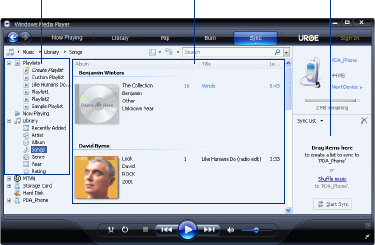
Experiencing Multimedia 201
Playlists and Library List Sync ListContent List
4. Click Start Sync to start synchronizing the selected files to your
device.
Notes • Use Windows Media® Player 11 or higher on your PC to synchronize media
files to your device.
• Audio files copy faster if Windows Media® Player is configured to
automatically set the quality level for audio files copied to your device. For
more information, see the Windows Media® Player Help.
Play media
Use the Library to find and play songs, videos, and playlists that are stored
on your device or removable storage card.
To update the Library
1. If you are not on the Library screen, tap Menu > Library.
2. On the Library screen, tap the Library arrow (near the top of the
screen), then tap the media storage that you want use, for example,
Storage Card.
3. In most cases, Windows Media® Player Mobile automatically updates
the library. However, you can manually update the library to ensure
that it contains new files that you recently copied to your device or
storage card. Tap Menu > Update Library to manually update the
library list.

202 Experiencing Multimedia
To play video and audio files on your device
1. Select a category (for example, My Music or My Playlists).
2. Tap and hold the item that you want to play (such as a song, album, or
artist name), then tap Play.
Tips • To play a media file that is stored on your device but is not in a library, on
the Library screen, tap Menu > Open File. Tap and hold the item that you
want to play (such as a file or a folder), then tap Play.
• To play a media file from the Internet or a network server, tap Menu >
Library then tap Menu > Open URL.
Playlists
In Windows Media® Player Mobile, you can create a new playlist by saving
the current Now Playing playlist and giving it a new name.
To save a new playlist
1. If you are not on the Library screen, tap Menu > Library.
2. Tap to select a category (for example, My Music or My Playlists).
3. Select a media file that you want, then tap Menu > Queue Up. This
adds the file to the Now Playing list.
Repeat this step until you have added all desired media files to the
Now Playing list.
Note You cannot select multiple files simultaneously.
4. After adding the media files, tap Menu > Now Playing.
5. On the Now Playing screen, tap Menu > Save Playlist.
6. Enter the playlist name then tap Done.
7. To play back the playlist you created, tap My Playlists in the Library,
select your playlist, then tap Play.
Troubleshooting
If you encounter a problem while using the Windows Media® Player Mobile,
a number of resources are available to help you troubleshoot the issue.
For more information, see the Troubleshooting Windows Media® Player
Mobile page at the Microsoft Web site (http://www.microsoft.com/
windows/windowsmedia/player/windowsmobile/troubleshooting.aspx).
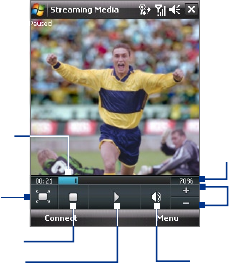
Experiencing Multimedia 203
12.5 Streaming Media
Streaming Media lets you stream live broadcasts or on-demand media
content from the Web. The media is sent in a continuous stream to your
device and is played as it arrives, along with the audio.
The Streaming Media program allows you to play 3GP and MPEG-4 files. It
also supports playback of SDP (Session Description Protocol) files.
To access streaming content via Internet Explorer
In Internet Explorer, you can open a Web page containing RTSP (Real Time
Streaming Protocol) links to streaming media content then play the content
in the Streaming Media program.
1. Tap Start > Internet Explorer.
2. In the address bar, enter the URL address of the Web page that
contains the RTSP link to the desired *.3gp, *.mp4, or *.sdp file.
3. On the Web page, tap the RTSP link.
4. Streaming Media then automatically opens and starts playing the file.
During playback, use the button controls to play/pause, zoom in or
out, adjust the sound volume, and more.
Full screen
Stop
Play/Pause Mute/Unmute
Increase/Decrease
volume
Volume level
Jog Bar
204 Experiencing Multimedia
To stream media files directly on the Streaming Media Player
Streaming Media only supports RTSP links when you stream *.3gp and
*.mp4 files directly on the program.
Note Before you launch the Streaming Media program, make sure that you are
connected to the Internet.
1. Tap Start > Programs > Streaming Media.
2. From the program, tap Connect.
3. Enter the URL for the Web site (rtsp://) and the file name.
4. Tap Connect.
5. Streaming Media then starts playing the file. During playback, use
the button controls to play/pause, zoom in or out, adjust the sound
volume, and more.
To view streaming video information
You can view the properties and general information of a streaming video
clip, such as video codec, audio codec, dimension, frames, and duration of
the video.
Tap Menu > Properties from the program.
To configure streaming video connection settings
Tap Menu > Options to configure the following settings:
• Connect via. Choose whether you want to connect to the Internet or
corporate network (intranet) to locate a streaming video clip.
• UDP port range. Specify a range of port numbers to use for
streaming.
• Media buffer. Specify the memory space (in terms of duration) to
allot for storing video and audio data while streaming media.
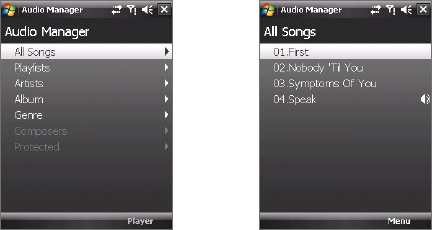
Experiencing Multimedia 205
12.6 Audio Manager
Audio Manager is a music browser and player in one. It gives you access
to all the music files on your device, and allows you to easily browse for the
music that you want to play by organizing music into categories such as
title, artist, album, etc. You can also create playlists of your favorite songs
and use the integrated Music Player to play them back.
To launch Audio Manager
• Tap Start > Programs > Audio Manager.
Notes • Audio Manager searches for all music files stored on your device memory
and memory card that have the following audio formats: MP3, WMA, AAC,
and AAC+. It will search in the following locations:
Device: My Music (including all subfolders)
\My Documents (including all subfolders)
Memory card: \Storage Card (including all subfolders)
• Music files are categorized under Artists, Album, Genre, etc. if such
metadata is found in the files.
Library
On the Audio Manager’s Library screen, an arrow that appears in an item
indicates that there is a submenu available. Tap the item name to open the
submenu.
Library: Main screen Library: All Songs screen
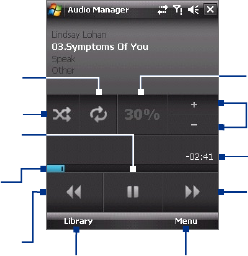
206 Experiencing Multimedia
When you tap a category on the Library’s Main screen, you will see more
submenus which may have deeper levels of menus. For example, when you
tap Artists, another level of submenus will be listed showing artist names.
When you tap an artist name, more submenus showing album names will
be displayed. Keep opening the submenus until you reach the level where
song titles can be selected for playback.
Music files that are protected by Digital Rights Management (DRM) will be
listed under the Protected category. A lock icon shown before song titles
indicates that the music files are protected. Select a file then tap Info if you
want to view file information. A cross-marked lock icon shown before song
titles indicates that the rights for the music files have expired, and you will
not be able to play them. Tap Delete if you want to delete these files.
Note Audio Manager keeps track of the last submenu that you accessed. When
you exit Audio Manager and open it again, it will display the last submenu
that you were in. Keep tapping the submenu name at the top of the screen
until you reach the Library's Main screen.
Music Player
When you select a music in the Library, Music Player opens and
automatically plays it. Use the available buttons to control the playback.
Repeat
Shuffle
Playback time
Play/Pause
Increase/Decrease
volume
Go to previous
song Return to
Library screen
Go to next song
Volume level
Open a menu where you can choose
to add the current song to a playlist,
set the song as ring tone, and more.
Drag the slider to
move forward or
backward in a song.
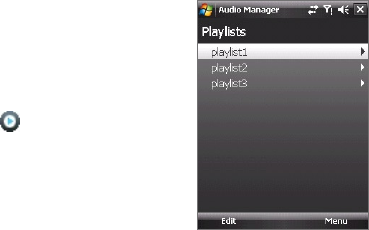
Experiencing Multimedia 207
Playlists
The Playlists screen shows the current playlists that are found on the device
memory and memory card.
There are two types of playlists that will be shown on the Playlist screen:
• Windows Media® Player playlists.
These are playlists that are in Windows
Media® Player Mobile’s Library (which
is synchronized with Windows Media®
Player on your computer), and they
are indicated by the Windows Media®
Player icon ( ). They can be played
in Audio Manager’s Music Player but
cannot be edited.
• Custom playlists. These are playlists
that are created in Audio Manager and
can be edited.
Notes • Audio Manager will search for playlists in the following locations:
Device: \Playlists
\Application Data\HTC\AudioManager\playlists
Memory card: \Storage Card\Playlists
• If a Windows Media® Player playlist contains a combination of music,
video and image files, Audio Manager accesses the music files only and
filters out the other media types.
To create a playlist
1. On the Library’s Main screen, tap Playlists.
2. On the Playlists screen, tap Menu > New.
3. Enter a Playlist name then tap OK.
4. On the Playlists screen, tap the playlist you have just created then tap
Edit.
5. Tap Menu > Add.
6. Tap the check boxes to select the songs you want to add to the
playlist, or tap Menu > Select All to choose all the songs.
7. Tap OK three times to return to the Playlists screen.
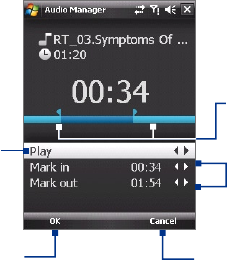
208 Experiencing Multimedia
To play back a playlist
1. On the Playlists screen, tap to select a playlist.
2. Tap the first song in the selected playlist. Music Player automatically
opens and starts playing the first song. After each song, the next one
in the playlist will be played.
Note The content of playlists is not automatically updated when music files have
been deleted from the device memory or memory card. Music Player will
display a notification message when music files in a playlist cannot be found.
Set music as ring tone
You can set your favorite music as a ring tone for your device.
1. Use the NAVIGATION CONTROL to select a song in the Library or tap a
song to play it in Music Player, then tap Menu > Set as Ring Tone.
2. If the selected music is an MP3 file, tap Trim if you want to trim it first
to make it shorter.
Play/Stop
Mark the part of the music that
will be used as the ring tone.
Drag the left handle to mark the
start time (mark-in point), then
drag the right handle to mark
the end time (mark-out point).
For more precise marking, you
can also tap these controls to
step backward/forward one
step and mark it.
Confirm
trimming the
ring tone.
Cancel
trimming.
3. Tap Set as Default Ring Tone.
Tip If you only want to save the song to the ring tone folder for future use,
tap Save to Ring Tone Folder. Later on, you can tap Start > Settings >
Personal tab > Phone to set it as your ring tone.
4. A confirmation message is then displayed. Tap OK.
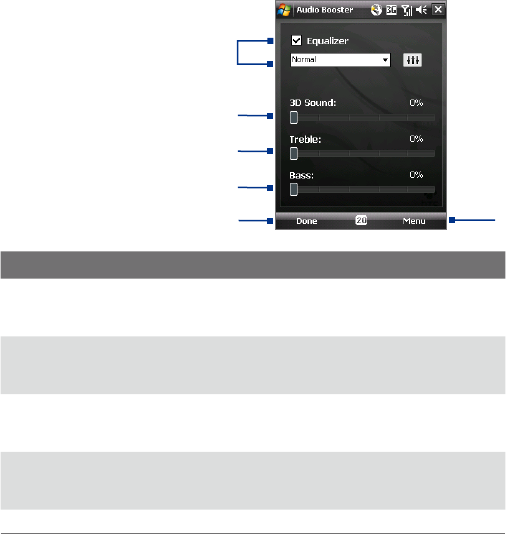
Experiencing Multimedia 209
12.7 Using Audio Booster
Audio Booster enhances your music experience by providing you with
controls for adjusting sound settings while you are listening to music. It
adds 3D sound, treble and bass effects, and provides controls for adjusting
them. It even has an equalizer with presets as well as a control panel for fine
tuning sound.
To access Audio Booster
• Tap Start > Programs
> Audio Booster.
2
6
3
1
4
5
This control Does this
1Equalizer Enables or disables the equalizer. Select the check box to
enable the equalizer and to fine tune its settings, if desired.
See "Equalizer" for more information.
23D Sound Adds a three-dimensional effect to sound. Drag the slider
to increase or decrease the effect. To disable the 3D effect,
adjust the setting to 0%.
3Treble Adds a treble effect to increase the high tones in sound. Drag
the slider to increase or decrease the effect. To disable the
treble effect, adjust the setting to 0%.
4Bass Adds a bass effect to increase the low tones in sound. Drag
the slider to increase or decrease the effect. To disable the
bass effect, adjust the setting to 0%.
5Done Tap to apply the modified settings.
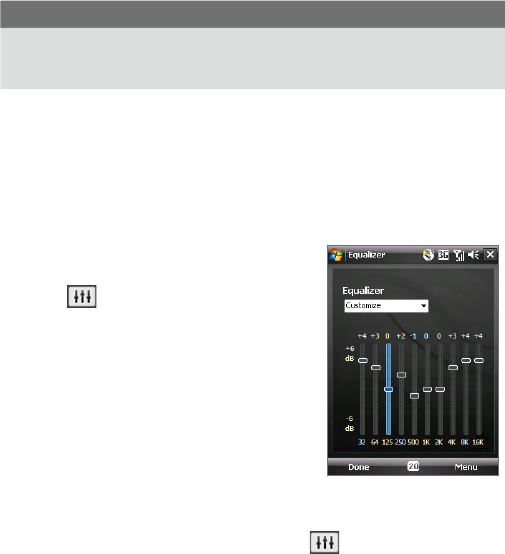
210 Experiencing Multimedia
This control Does this
6Menu • Tap Menu > Cancel to exit Audio Booster without applying
the modified settings:
• Tap Menu > Reset to change back to the default settings.
Equalizer
The Equalizer optimizes sound for a better listening experience. It provides
preset moods, such as hip hop, jazz, rock, etc., and several enhancement
presets that suit different types of music. It also has a 10-band graphic
equalizer that lets you adjust the loudness of sound by frequency.
To create a custom equalizer preset
1. Select the Equalizer check box to
enable the equalizer.
2. Tap .
3. Adjust the frequency bands to your
desired values by dragging the
equalizer controls. The selected values
are indicated on top of the sliders.
4. Save your equalizer settings as a preset
by tapping Menu > Save as Preset.
5. Enter a preset name then tap Done.
The preset you created will be added to the
list box.
To delete a custom equalizer preset
1. Select the Equalizer check box then tap .
2. Tap the list box then select the preset you want to delete.
3. Tap Menu > Delete Preset.
Note You can only delete custom equalizer presets. Equalizer presets that are pre-
installed cannot be deleted.
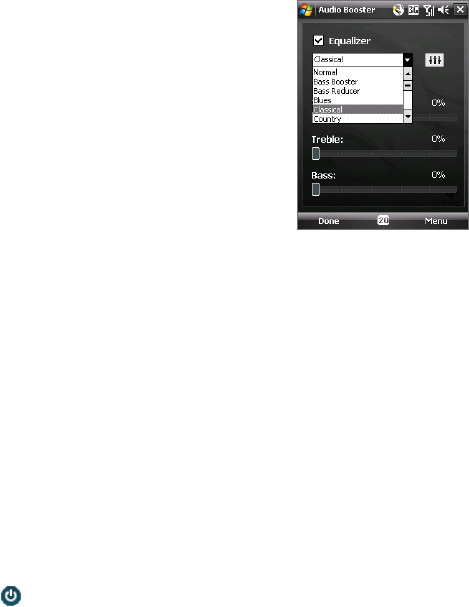
Experiencing Multimedia 211
To apply a preset
1. Select the Equalizer check box to
enable the equalizer.
2. Tap the list box then select a desired
preset.
12.8 Using FM Radio
FM Radio allows you to listen to FM radio stations on your device. Since FM
Radio uses the provided stereo wired headset as an antenna, you must plug
in the headset first onto the earphone jack of your device before you open
the program. You can switch between the wired headset and speaker when
listening to FM.
To open FM Radio
• Tap Start > Programs > FM Radio.
The first time this program is used, it will automatically scan for
available FM channels in your area, save them as presets, then play
the first FM station found. For information about saving favorite
stations as presets, see “Saving presets.“
When you tap the Exit icon on the top right of the FM Radio screen, the
program continues to run in the background and allows you to continue
listening to the radio while you use other programs. To turn off the FM radio,
tap on the upper left corner of the FM Radio screen.
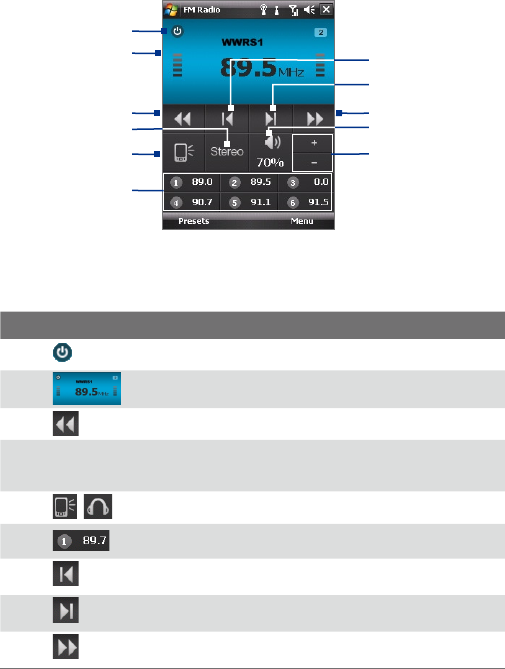
212 Experiencing Multimedia
FM Radio controls
1
2
3
4
8
11
7
6
9
5
10
Tip Tap Menu to choose more options for FM Radio, such as Scan & Save to
perform a rescan of the FM band for available FM stations and save them as
presets, and more.
This control Does this
1Turns off the FM radio.
2See “Radio Display” for details.
3Decreases the radio frequency by 0.1MHz.
4Stereo/Mono
Allows you to switch between Mono and Stereo modes.
There are times that FM radio stations sound clearer
when you listen to them in Mono mode.
5 Switches between speaker and headset output.
6Allows you to save up to six favorite FM stations as
presets. Tap a button to tune in to a favorite station.
7Searches the FM band for the next lower FM channel.
8Searches the FM band for the next higher FM channel.
9Increases the radio frequency by 0.1MHz.
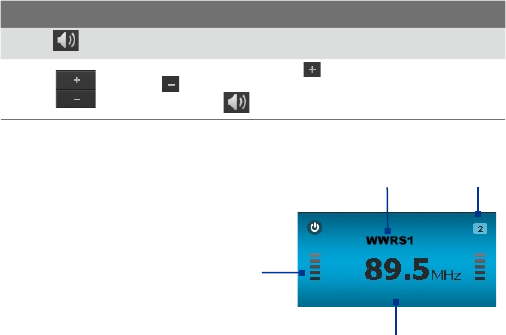
Experiencing Multimedia 213
This control Does this
10 Turns the sound on or off.
11
Adjusts the volume. Tap to increase the volume. Tap
to decrease the volume. The volume level is displayed
below the icon.
Radio Display
1Shows the station name when
the RDS (Radio Data System)
or RDBS (Radio Data Broadcast
System) signal is available.
1
3
2
4
2Shows the preset number
when you select a preset FM
station.
3Shows the received signal
strength.
4Shows the radio frequency.
Device controls used in FM Radio
Navigation
• Press NAVIGATION left/right to search the FM band for the next lower/
higher FM channel. When the search reaches the last station, it cycles
back to the beginning of the FM band.
• Press NAVIGATION up/down to select the previous/next available
preset station.
• Press the ENTER button to toggle mute on and off.
NAVIGATION Wheel
• Rotate the NAVIGATION Wheel clockwise to increase the volume,
counterclockwise to decrease the volume.
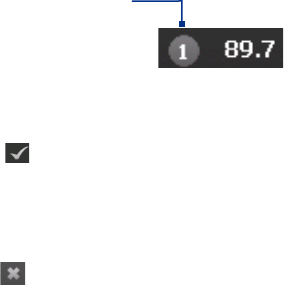
214 Experiencing Multimedia
Saving presets
Presets are favorite FM stations that you can save for easy access. You can
save up to six FM stations to the preset buttons on the main FM Radio
screen, or save up to 20 presets on the Presets screen.
To save FM stations to the preset buttons
1. Tune to the desired FM frequency.
2. Tap the number on a preset
button. The frequency number of
your favorite FM station will be
displayed on the preset button.
Tap here
Tapping a preset button that is already set replaces the frequency.
To save FM stations on the Presets screen
1. Tune to the desired FM frequency, then tap Presets.
2. On the Presets screen, tap that appears on the desired preset
number where you want to save the FM station.
You can save up to 20 preset radio stations. Radio stations that are
saved on Presets 1 to 6 can be accessed on the main FM Radio screen.
3. When done, tap OK.
Tip On the Presets screen, tap to remove a favorite FM station from the list.
To listen to a preset FM station
Do one of the following:
• On the main FM Radio screen, tap the preset button that shows your
favorite station.
• On the Preset screen, select a preset number that shows your favorite
station, then tap Listen.
Experiencing Multimedia 215
FM Radio Main Menu
Tap Menu on the FM Radio screen to access options for the FM Radio
program.
Scan & Save Automatically scan radio stations that can be picked up by
the device and save them as presets. Existing presets will be cleared and
replaced with the newly scanned radio stations. You can have a maximum
of 20 preset radio stations.
Stereo Toggles between using Stereo or Mono mode when listening to an
FM radio station.
Mute Toggles between muting and restoring the volume.
Output Select whether to use the device Speaker or Wired Headset to listen
to the radio.
Sleep Set how much time must pass before FM Radio goes into sleep mode.
The Sleep option is switched to Off every time you launch FM Radio.
Broadcast band Sets the radio band. Select Japan if you are listening to
radio in Japan. Otherwise, select Other countries.
About Displays information about the FM Radio program.
216 Experiencing Multimedia
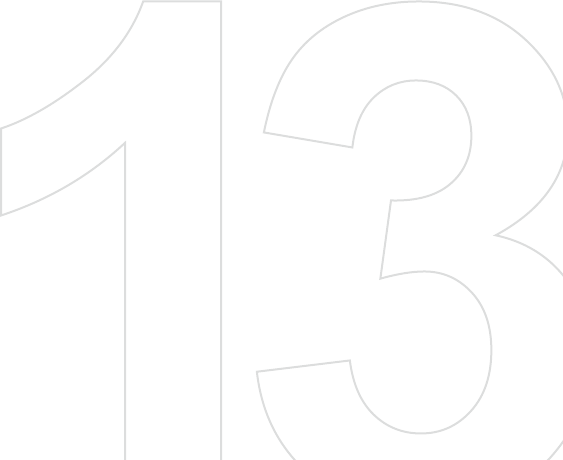
Chapter 13
Managing Your Device
13.1 Adding and Removing Programs
13.2 Using Task Manager
13.3 Resetting Your Device
13.4 Managing Memory
13.5 Windows Update
13.6 Battery Saving Tips

218 Managing Your Device
13.1 Adding and Removing Programs
Before you purchase additional programs for your device, make sure that
they are compatible with your device.
To add programs
1. Download the program to your PC (or insert the CD or disk that
contains the program into your PC).
You may see a single *.exe file, a *.zip file, a Setup.exe file, or several
versions of files for different device types and processors. Be sure to
only select programs designed for your device and processor type.
2. Read any installation instructions or documentation that comes with
the program. Many programs provide special installation instructions.
3. Connect your device to the PC.
4. Double-click the *.exe file.
To remove programs
1. Tap Start > Settings > System tab > Remove Programs.
2. In the Programs in storage memory list, select the program you
want to remove, and tap Remove.
13.2 Using Task Manager
Task Manager lets you view and stop running programs, configure the
button, and enable the Quick Menu on the Today screen.
To open Task Manager
• Tap the Quick Menu button on the top right corner of the Today
screen to open the Quick Menu, then tap .
• Tap Start > Settings > System tab > Task Manager.
To switch back to a running program
• Tap the program name in the Quick Menu.
• On the Task Manager screen, tap and hold the program name in the
Running tab, then tap Activate.

Managing Your Device 219
To configure the Exit ( ) button
You can configure the Exit button to shut down running programs when
the button is tapped, or to just temporarily close the program screen but
keep the program running.
1. On the Task Manager screen, tap the Button tab.
2. Select the Enable the “X” button to end running programs check
box.
Note When the Enable the “X” button to end running programs check box
is not selected, tapping the Exit button will only close a program screen.
The program is not ended and continues to run in the background.
3. Choose the action for shutting down programs (by tapping the
button, tapping and holding the button, or both).
4. Tap OK.
To close running programs from the Task Manager
1. Tap the Running tab.
2. Do one of the following:
• Select the check box of the programs that you want to close, and
then tap Stop Selected to close them.
• Tap Stop All to close all programs in the list.
• Tap Menu > Stop All but Selected to close all programs except
for those whose check boxes are selected.
Tip You can also close running programs from the Quick Menu on the Today
screen. See "Quick Menu" in Chapter 1 for details.
To add a running program to the exclusive list
If you add a running program to the Exclusive Programs List, it will not be
closed when you tap Stop Selected or Stop All and will not be listed in the
Quick Menu on the Today Screen.
1. On the Task Manager screen, tap the Running tab.
2. Tap and hold the program name then tap Add Exclusive.
Tip To remove a program from the exclusive list, tap the Exclusive tab, select the
check box of that program, then tap Remove.

220 Managing Your Device
To set the sorting preference for running programs in the Quick Menu
1. On the Task Manager screen, tap the Advanced tab.
2. Choose whether to sort according to Program name or Memory
usage. The list will be sorted in ascending order.
13.3 Resetting Your Device
Soft reset
Occasionally, you may need to reset your device. A soft (or normal) reset
of your device clears all active program memory and shuts down all
active programs. This can be useful when your device is running slower
than normal, or a program is not performing properly. A soft reset is
also necessary after the installation of some programs. If a soft reset is
performed when programs are running, unsaved work will be lost.
To perform a soft reset
Use the stylus to press the RESET
button found at the bottom of your
device. Your device restarts and
displays the Today screen.
RESET button
Hard reset
You can also perform a hard reset (also known as a full reset). A hard
reset should be performed only if a normal reset does not solve a system
problem. After a hard reset, the device is restored to its default settings—
the way it was when you first purchased it and turned it on. Any programs
you installed, data you entered, and settings you customized on your
device will be lost. Only Windows Mobile® software and other pre-installed
programs will remain.
Warning! Your device will be set back to factory default settings. Please ensure any
additional installed programs and/or user data have been backed up
before a hard reset is performed.

Managing Your Device 221
Important If Encrypt files placed on storage cards is or was enabled before,
then backup all files from the storage card before using Clear Storage,
performing a hard reset, or updating the ROM system software. Otherwise
you will no longer be able to access the encrypted files on the storage
card. Use ActiveSync or Windows Mobile Device Center to transfer files
between your storage card and computer. After the procedure, copy your
files back to the storage card.
To perform a hard reset
1. Press and hold the GPS/MESSAGING and INTERNET EXPLORER
buttons, and at the same time, use the stylus to press the RESET
button at the bottom of your device.
2. Release the RESET button, but
continue pressing the GPS/
MESSAGING and INTERNET
EXPLORER buttons until you
see this message on the
screen:
This operation will delete
all your personal data,
and reset all settings
to manufacturer default.
Press Send to restore
manufacturer default, or
press other keys to cancel.
3. Release the buttons, and then press SEND on your device to perform
the hard reset, or press any other button to cancel the reset.
Clear Storage
Another way of clearing the device storage and reset all settings back to
factory default settings is to use the Clear Storage feature. You will lose all
your data and files on the device storage when you use Clear Storage, so
make sure to do a backup first.
Important If Encrypt files placed on storage cards is or was enabled before, then
backup all files from the storage card before using Clear Storage, hard
reset or updating the ROM system software. Otherwise you will no longer
be able to access the encrypted files on the storage card. Use ActiveSync
or Windows Mobile Device Center to transfer files between your storage
card and computer. After the procedure, copy your files back to the
storage card.
1. Tap Start > Settings > System tab > Clear Storage.
2. Enter “1234” then tap Yes.
222 Managing Your Device
13.4 Managing Memory
To see how much memory is available for use, tap Start > Settings >
System tab > Memory. On the Main tab, the amount of memory allocated
to data storage versus program storage is displayed, as well as the amount
of memory in use versus the available memory.
To see available storage card memory, tap Start > Settings > System tab >
Memory > Storage Card tab.
If your device is running low on memory, try the following to free memory
on your device:
• Close programs you are not currently using.
• Move e-mail attachments to a storage card.
• Move files to a storage card. Tap Start > Programs > File Explorer.
Tap and hold the file, and tap Cut. Browse to the storage card folder
and tap Menu > Edit > Paste.
• Delete unnecessary files. Tap Start > Programs > File Explorer. Tap
and hold the file, and tap Delete.
• Delete large files. To find your largest files, tap Start > Programs >
Search. In the Type list, tap Larger than 64 KB, and tap Search.
•
In Internet Explorer Mobile, delete temporary Internet files and clear
history information. For more information, see “Internet Explorer
®
Mobile” in Chapter 10.
• Remove programs you no longer use.
• Reset your device.
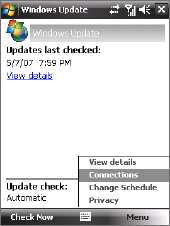
Managing Your Device 223
13.5 Windows Update
You can update Windows Mobile® on your device with the latest updates,
security patches or fixes, if they are available.
To set up Windows Update
The first time you run Windows Update, you need to set up how you want
Windows Update to check for patches on the Microsoft Web site.
1. Tap Start > Settings > Systems tab > Windows Update.
2. On the Update Setup screen, tap Next.
3. Select how you want to check for updates, Manual or Automatic,
then tap Next.
Note If you select Automatic, you will be asked if you want to use your
current data plan to check for updates. Select or clear the Use my data
plan to check for and download updates check box and tap Next.
4. Tap Finish.
To check for updates
1. Tap Start > Settings > Systems tab > Windows Update.
2. Tap Check Now.
Note Windows Mobile® updates may not be available at all times. Check the
Windows Mobile® Web site for update information.
To change Windows Update options
1. Tap Start > Settings > Systems tab >
Windows Update.
2. Tap Menu and select the option you
want to change.
• Tap Connections to change
how the device connects to
the Internet when checking for
updates.
• Tap Change Schedule to change
how Windows Update checks for
Windows Mobile® updates.
224 Managing Your Device
13.6 Battery Saving Tips
How long your battery power lasts depends on battery type and how you
use your device. Try the following to help preserve battery life:
• When the device is not in use, press POWER to switch off the display.
• Tap Start > Settings > System tab > Power to open the Power
settings screen. On the Advanced tab of the Power settings screen,
you can specify when your device automatically turns off the display
to conserve battery power. For optimum conservation, specify 3
minutes or less.
• Use the AC adapter to plug your device into external power whenever
possible, especially when using a storage card or when using a
modem or other peripherals.
• Adjust the backlight settings. For more information, see “To set the
backlight to dim after a time delay” in Chapter 4.
• When you know you are out of range of your Wi-Fi networks, turn
Wi-Fi off. Searching for networks consumes a lot of power. For more
information about Wi-Fi, see Chapter 10.
• Turn Bluetooth off when you are not using it. Make your device visible
to other devices only when you are trying to establish a Bluetooth
partnership. For more information about Bluetooth, see Chapter 10.
• Lower the volume.
• Close battery-intensive programs, such as the Camera, when you
are done using them. Make sure the programs are ended and are
not continuously running in the background. Refer to “Using Task
Manager” in this chapter for information on closing programs.

Chapter 14
Using Other Applications
14.1 Voice Speed Dial
14.2 Java
14.3 Spb GPRS Monitor
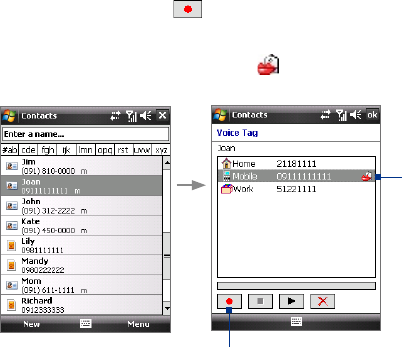
226 Using Other Applications
14.1 Voice Speed Dial
You can record voice tags so that you can dial a phone number or launch
programs simply by speaking a word.
Create a voice tag for a phone number
1. Tap Start > Contacts to open the Contacts list.
2. Do one of the following:
• Tap and hold the desired contact, then tap Add Voice Tag.
• Select the desired contact, then tap Menu > Add Voice Tag.
• Tap the desired contact to open the contact’s detailed screen, then
tap Menu > Add Voice Tag.
3. Select the phone number that you want to create a voice tag for, then
tap the Record button .
Tip To ensure voice recognition accuracy, record your voice in a quiet place.
4. When completed, a Voice Tag icon is displayed on the right of the
item.
Select the
desired phone
number.
Tap the Record button to start recording.

Using Other Applications 227
5. When you create a voice tag for the item, you can do one of the
following:
• Tap the Record button to rebuild the voice tag.
• Tap the Play button to play the voice tag.
• Tap the Delete button to delete the voice tag.
Create a voice tag for a program
1. Tap Start > Settings > Personal tab > Voice Speed Dial >
Application tab.
2. The Application tab displays a list of all installed programs on your
device. The procedure for creating a voice tag for a program is the
same as the procedure for creating a voice tag for a phone number.
3. After you have created a voice tag for a program, you can then launch
the program by saying the recorded voice tag after tapping Start >
Programs > Voice Speed Dial.
Tip You can also launch the program by pressing the VOICE COMMAND
button on the left side of the device and saying the voice tag.
Make a call or launch programs using a voice tag
1. Tap Start > Programs > Voice Speed Dial.
2. After the beep, say the recorded voice tag that you have assigned
to the phone number you want to call or the program you want to
launch. The system will repeat the voice tag and then dial out or
launch the program automatically.
Note If the system cannot recognize your voice tag, move to a quiet place, then try
again while speaking clearly.
To view and test the voice tags you have created
1. Tap Start > Settings > Personal tab > Voice Speed Dial.
2. The Voice Tag tab displays a list that contains all the voice tags
you have created. Select an item in the list, and then do one of the
following:
• Tap the Record button ( ) to rebuild the voice tag.
• Tap the Play button ( ) to play the voice tag.
• Tap the Delete button ( ) to delete the voice tag.
228 Using Other Applications
14.2 Java
MIDlets are Java applications such as games and tools that can run on
mobile devices, while a MIDlet suite is a collection of one or more MIDlets.
The Java program lets you download, install and manage MIDlets or MIDlet
suites on your device. Your device supports Java 2 Micro Edition, J2ME.
To open the Java program
• Tap Start > Programs > Java.
Install and launch MIDlets/MIDlet suites
There are several ways to install a MIDlet/MIDlet suite.
To download and install via Internet Explorer Mobile
1. Tap Menu > Install > Browser to open Internet Explorer Mobile.
2. Locate the MIDlet/MIDlet suite while connected to the Internet.
3. Select the MIDlet/MIDlet suite to download.
4. Information about the MIDlet/MIDlet suite is then displayed. Tap
Continue.
5. Confirm to start downloading.
6. Select <root> or a folder where to install the MIDlet suite to, then tap
OK.
To install from your device
You can copy MIDlets/MIDlet suites from the PC to your device using the
USB sync cable or Bluetooth connection. Copy them to the root folder or
any subfolder on your device.
1. Tap Menu > Install > Local Files. The program then searches for
MIDlets/MIDlet suites on your device and displays them in a list.
2. From the list, tap the MIDlet/MIDlet suite that you want to install.
3. Confirm to start the installation.
4. Select <root> or a folder where to install the MIDlet suite to, then tap
OK.
Using Other Applications 229
To run a MIDlet/MIDlet suite
Do one of the following:
• After installation of the MIDlet/MIDlet suite is complete, tap Yes.
• On the Java screen, open the folder that contains the MIDlet/MIDlet
suite. Select the MIDlet/MIDlet suite then tap Launch.
To stop running a MIDlet/MIDlet suite
• Tap Exit or Quit if presented on the MIDlet/MIDlet suite’s screen or
menu.
Manage MIDlets/MIDlet suites
You can organize MIDlets/MIDlet suites into folders for easy identification,
rename or update them, and more. If the device memory is full, uninstall
some MIDlets/MIDlet suites to free up memory space.
To create folders
1. On the Java screen, tap Menu > New Folder.
2. Enter a folder name then tap Create.
To rename a MIDlet or folder
1. Tap and hold a MIDlet/MIDlet suite or folder then tap Rename.
Alternatively, you can tap Menu > Actions > Rename.
2. Enter a new name, then tap Save.
To update a MIDlet/MIDlet suite
Tap and hold a MIDlet/MIDlet suite then tap Update. Alternatively, you can
tap Menu > Actions > Update.
Java will search for updates for the selected MIDlet/MIDlet suite where it
was installed from before.
To uninstall MIDlets
Before you uninstall a MIDlet, make sure that it is not running.
1. Tap and hold the MIDlet, and tap Uninstall.
2. Tap OK to confirm.
Note To uninstall all MIDlets and folders from the current folder, tap Menu >
Uninstall All.
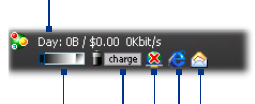
230 Using Other Applications
14.3 Spb GPRS Monitor
Using Spb GPRS Monitor, you can monitor how much data you have sent
and received on your device, and check the network usage costs by taking
into account your service plan details. You can also view connection cost
and traffic charts, generate reports of network connection usage, and
export reports to CSV files for use with Microsoft® Office Excel® and Access.
Install GPRS Monitor
The GPRS Monitor program is included on the Application CD. To install
it onto your device, run the program’s installer on your PC. Follow the on-
screen instructions on your PC and your device to complete the installation.
The Today Plug-in
After you have installed GPRS Monitor on your device, you will find its
program icon in Start > Programs. In addition, GPRS Monitor is also added
to the Today screen as a plug-in which shows connection statistics, a
brightness panel, battery panel, and shortcut icons.
1
2 3 4 5 6
1 Tap to open the GPRS Monitor screen where you can set up
monitoring, view cost and traffic charts, and generate reports.
2 Tap inside the control bar to adjust the backlight level.
3 This is the battery power monitor. Tap it to access the Power Settings
screen.
4 Tap to toggle between connecting or disconnecting your default data
connection.
5 Tap to open Internet Explorer Mobile.
6 Tap to open Messaging.
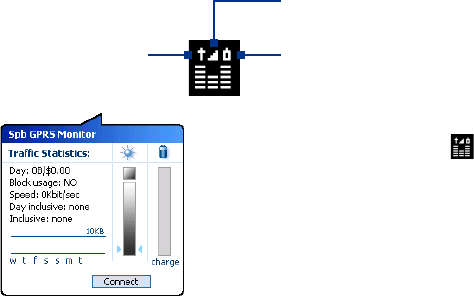
Using Other Applications 231
The GPRS Monitor icon and pop-up window
Another way of displaying status information visually is by enabling the
GPRS Monitor icon to be shown on the title bar. This icon shows the GPRS/
dial-up connection speed, data traffic, and battery status.
To show the GPRS Monitor icon on the title bar
1. Tap Start > Programs > Spb GPRS Monitor.
2. Tap Tools > Options > Icon tab.
3. Select the Show taskbar icon check box.
By default, the GPRS Monitor icon shows three bars that represent the
following status information:
Icon Bar 2: Traffic
(Full bar corresponds to
100%. Each bar is 20%.)
Icon Bar 3: Battery
(Each bar corresponds to
20% of the total charge.)
Icon Bar 1: Speed
(Full bar corresponds
to 19KB/sec.)
When you tap the GPRS Monitor icon
on the title bar, a pop-up window opens
and shows you detailed statistics about data
transfers, such as the data size just transferred
and its cost, the data amount left that you are
allowed to transfer, and more.
Set up monitoring and notification
To select the connection to be monitored
1. On the GPRS Monitor screen, tap Tools > Options > Connection tab.
2. Select the Enable connection monitoring check box.
3. In the Connection list, select the connection you want to monitor.
232 Using Other Applications
To enter your service plan details
Service plan details, or tariffs, determine the price that you pay for your
data transfers. The tariff may either be flat rate or time-based, depending on
whether you’re using GPRS or a phone dial-up connection for data transfers.
Contact your service provider to find out about your tariff, and enter the
information in the Tariff tab or the Tariff Details tab on the Options screen.
Note The calculation of network usage costs is based on the information that you
entered, and is an estimate only. The actual amount billed by your service
provider may differ.
To set up traffic limit notifications
You can set up traffic limit notifications if you want to be notified when a
traffic limit is reached.
1. On the GPRS Monitor screen, tap Tools > Options.
2. Enable the notifications on the Day Warn and Month Warn tabs. You
can specify up to three daily and three monthly limits.
Once traffic reaches one of these limits, you will receive a notification.
View charts and reports
On the GPRS Monitor, you can view network connection cost charts and
traffic charts, as well as generate detailed reports of network connection
usage during a given period of time. These reports can be exported to CSV
files that you can open using Excel, Access, or other similar spreadsheet and
database software.
To view charts and generate reports
On the GPRS Monitor screen:
• Tap the Chart tab to view the network connection cost charts and
traffic charts.
• Tap the Report tab to generate reports on network traffic and tariff.
For more information about using Spb GPRS Monitor, see Help on your
device.
Appendix
A.1 Regulatory Notices
A.2 Specifications
234 Appendix
A.1 Regulatory Notices
Regulatory Agency Identifications
For regulatory identification purposes, your product is assigned a model
number of POLA100.
To ensure continued reliable and safe operation of your device, use only the
accessories listed below with your POLA100.
The Battery Pack has been assigned a model number of POLA160.
Note This product is intended for use with a certified Class 2 or Class 3 Limited
Power Source, rated 5 Volts DC, maximum 1 Amp power supply unit.
Federal Communications Commission Notice
This device complies with part 15 of the FCC Rules. Operation is subject
to the following two conditions: (1) This device may not cause harmful
interference, and (2) this device must accept any interference received,
including interference that may cause undesired operation.
This equipment has been tested and found to comply with the limits for a
Class B digital device, pursuant to Part 15 of the FCC Rules. These limits are
designed to provide reasonable protection against harmful interference in
a residential installation. This equipment generates, uses, and can radiate
radio frequency energy and, if not installed and used in accordance with
the instructions, may cause harmful interference to radio communications.
However, there is no guarantee that interference will not occur in a
particular installation. If this equipment does cause harmful interference to
radio or TV reception, which can be determined by turning the equipment
on and off, the user is encouraged to try to correct the interference by one
or more of the following measures:
• Reorient or relocate the receiving antenna.
• Increase the separation between the equipment and receiver.
• Connect the equipment into an outlet on a circuit different from that
to which the receiver is connected.
• Consult the dealer or an experienced radio or television technician for
help.
Appendix 235
Modifications
The FCC requires the user to be notified that any changes or modifications
made to the device that are not expressly approved by High Tech Computer
Corporation may void the user’s authority to operate the equipment.
Safety precautions for RF exposure
• Use only original manufacturer-approved accessories, or accessories
that do not contain any metal.
• Use of non-original manufacturer-approved accessories may violate
your local RF exposure guidelines and should be avoided.
Exposure to Radio Frequency (RF) Signals
Your device contains a radio transmitter and receiver. The radiated output
power is far below the international radio frequency exposure limits. These
limits are part of comprehensive guidelines and establish permitted levels
of RF energy for the general population. The guidelines are based on the
safety standards previously set by international standards bodies:
• American National Standards Institute (ANSI) IEEE. C95.1-1992
• National Council on Radiation Protection and Measurement (NCRP).
Report 86. 1986
• International Commission on Non-Ionizing Radiation Protection
(ICNIRP) 1996
• Ministry of Health (Canada), Safety Code 6. The standards include a
substantial safety margin designed to assure the safety of all persons,
regardless of age and health.
The exposure standard for wireless mobile phones employs a unit of
measurement known as the Specific Absorption Rate, or SAR. The standard
incorporates a substantial margin of safety to give additional protection for
the public and to account for any variations in usage.
As with other mobile radio transmitting equipment, users are advised that
for satisfactory operation of the equipment and for the safety of personnel,
it is recommended that no part of the human body be allowed to come too
close to the antenna during operation of the equipment.
Your device has an internal antenna. Use only the supplied integral antenna.
Use of unauthorized or modified antennas may impair call quality and
236 Appendix
damage the phone, causing loss of performance and SAR levels exceeding
the recommended limits as well as result in non-compliance with local
regulatory requirements in your country.
To assure optimal phone performance and ensure human exposure to RF
energy is within the guidelines set forth in the relevant standards; always
use your device only in its normal-use position. Do not touch or hold the
antenna area unnecessarily when placing or receiving a phone call. Contact
with the antenna area may impair call quality and cause your device to
operate at a higher power level than needed. Avoiding contact with the
antenna area when the phone is IN USE optimizes the antenna performance
and the battery life.
Body-worn measurements were tested for typical body-worn operations
with the back of the device kept 1.5 cm from the body.
SAR Information
1.190 W/Kg @ g (Head)
1.290 W/Kg @ g (Body)
Telecommunications & Internet Association (TIA) safety
information
Pacemakers
The Health Industry Manufacturers Association recommends that a
minimum separation of six inches be maintained between a handheld
wireless phone and a pacemaker to avoid potential interference with the
pacemaker. These recommendations are consistent with the independent
research by and recommendations of Wireless Technology Research.
Persons with pacemakers:
• Should ALWAYS keep the phone more than six inches from their
pacemaker when the phone is turned ON.
• Should not carry the phone in a breast pocket.
• Should use the ear opposite the pacemaker to minimize the potential
for interference. If you have any reason to suspect that interference is
taking place, turn the phone OFF immediately.
Hearing Aids
Some digital wireless phones may interfere with some hearing aids. In the
event of such interference, you may want to consult your service provider,
or call the customer service line to discuss alternatives.

Appendix 237
Other Medical Devices
If you use any other personal medical device, consult the manufacturer
of your device to determine if they are adequately shielded from external
RF energy. Your physician may be able to assist you in obtaining this
information.
Turn the phone OFF in health care facilities when any regulations posted in
these areas instruct you to do so. Hospitals or health care facilities may be
using equipment that could be sensitive to external RF energy.
WEEE Notice
The Directive on Waste Electrical and Electronic Equipment (WEEE), which
entered into force as European law on 13th February 2003, resulted in a
major change in the treatment of electrical equipment at end-of-life.
The purpose of this Directive is, as a first priority, the prevention of WEEE,
and in addition, to promote the reuse, recycling and other forms of recovery
of such wastes so as to reduce disposal.
The WEEE logo (shown at the left) on the product or on its box
indicates that this product must not be disposed of or dumped
with your other household waste. You are liable to dispose of all
your electronic or electrical waste equipment by relocating over
to the specified collection point for recycling of such hazardous
waste. Isolated collection and proper recovery of your electronic
and electrical waste equipment at the time of disposal will
allow us to help conserving natural resources. Moreover, proper
recycling of the electronic and electrical waste equipment will
ensure safety of human health and environment. For more
information about electronic and electrical waste equipment
disposal, recovery, and collection points, please contact your
local city center, household waste disposal service, shop from
where you purchased the equipment, or manufacturer of the
equipment.
RoHS Compliance
This product is in compliance with Directive 2002/95/EC of the European
Parliament and of the Council of 27 January 2003, on the restriction of the
use of certain hazardous substances in electrical and electronic equipment
(RoHS) and its amendments.

238 Appendix
A.2 Specifications
System Information
Processor Qualcomm® MSM7200TM 400MHz
Memory – ROM : 256 MB
– RAM : 128 MB DDR SDRAM
Note: Figures are the total ROM and RAM memory available for use
and storage. Since the memory is shared by the Operating System,
applications, and data, the actual available memory is less than
what is written.
Operating System Windows Mobile® 6 Professional
Power
Battery Rechargeable Lithium-ion battery, 1350 mAh
Charging Time 2.5 - 3 hours
Battery Life
(estimates)
Standby time: Up to 400 hours for GSM
Up to 450 hours for UMTS
(Subject to network and phone usage)
Talk time: Up to 7 hours for GSM
Up to 4 hours for UMTS
Up to 2.3 hours for video call
(Subject to network and phone usage)
Media playback
time:
Up to 8 hours (WMV)
Up to 12 hours (WMA)
AC Adapter Voltage range/frequency: 100 - 240V AC, 50/60 Hz
DC output: 5V and 1A
Display
LCD Type 2.8-inch transmissive TFT-LCD with backlight LEDs, touch-
sensitive screen
Resolution 240 x 320 with 65,536 colors
Alignment Portrait and Landscape
HSDPA / UMTS / GSM / GPRS / EDGE Module
Functionality HSDPA/UMTS: 2100MHz for Europe, 850/1900MHz for
USA
HSDPA: Up to 384kbps for upload and
3.6Mbps for download
UMTS: Up to 384kbps for upload and
download
GSM/GPRS/EDGE: Quad-band (850, 900, 1800, and 1900)

Appendix 239
Internal Antenna Yes
Physical
Dimensions 110 mm (L) x 58 mm (W) x 15.5 mm (T)
Weight 130 g (with battery)
Camera Module
Type Main camera: 3.0 Megapixel color CMOS camera
Second camera: VGA CMOS camera
Resolution Photo: 2048x1536, 1600x1200 (UXGA), 1280x960 (SXGA),
640x480 (VGA), 320x240 (QVGA), 160x120 (QQVGA)
Video: 176x144 (QCIF), 128x96
Digital Zoom Up to 8X
Connections
I/O Port HTC ExtUSBTM : an 11-pin mini-USB and audio jack in
one (ExtUSB is a proprietary connection interface that is
trademarked by HTC).
GPS Antenna
Connector
Yes. Please use only the external GPS antenna with model
number GA S120.
Wireless
Connections
Bluetooth 2.0, Wi-Fi (IEEE 802.11 b/g)
GPS
Chipset QCT MSM7200 with XTRA support
Internal GPS
Antenna
Yes
GPS Accuracy Within 15 meters, 95% typical
Expansion Slots
Card Slot microSD™ (SD 2.0 compatible)
FM Radio/RDS
Chipset TI BRF6350
Tuning Range 76 - 108 MHz
Frequency
Response
20~15 kHz
Auto Channel
Search
Yes

240 Appendix
RDS/RBDS • Radio Data Service (RDS)/Radio Broadcast Data Service
(RBDS) decoder
• Integrated RDS/RBDS demodulator in accordance with
EN50067
Controls and Lights
Device Control • HTC TouchFLO™
• 4-way NAVIGATION WHEEL with ENTER button
• Two phone functions : TALK and END
• Two program buttons : Voice Command and Camera
• POWER button
• RESET button
LEDs The right bi-color LED shows green and amber lights for
HSDPA/UMTS/EDGE/GSM/GPRS standby, message, and
network status as well as for notification and battery
charging status. Shows a flashing red light when the
battery level reaches 5% or lower.
The left bi-color LED shows a flashing blue light for
Bluetooth system notification of powered-up and ready
to transmit or receive Bluetooth signals, or a flashing
green light for Wi-Fi status. When both Bluetooth and
Wi-Fi are enabled, their lights flash alternately. Shows
flashing amber light for GPS status.
Audio
Audio Controller AGC
Ring tone • 40 polyphonic and standard MIDI format 0 and 1
(SMF)/SP MIDI
• MP3, AAC, AAC+, WMA, WAV, and AMR-NB
Windows Media
Player
MP3, WMA, MID, AMR, AWB, M4A
Index
Symbols
3D sound 209
3G 153
A
A2DP 166
ActiveSync
- set up 91
- synchronize 92, 131
Add and remove programs 218
Adobe Reader LE 47, 141
Alarm 82
Answer/end a call 69
Appointment search 62
Attachment
- add to e-mail 123
- download 125
Audio Booster 47, 209
Audio Manager 47, 205
B
Backlight 80, 81
Back up data 144
Basic settings 80
Bass effects 209
Battery
- battery information 22
- charge battery 27
- save battery power 153, 224
Beam
- via Bluetooth 167
Block Recognizer 60
Bluetooth
- Bluetooth Explorer 47, 169
- Bluetooth le sharing 169
- Bluetooth shared folder 169
- hands-free headset 166
- modem 163
- modes 164
- overview 164
- partnership (pairing) 165
- SIM Access Prole (SAP) 77
- stereo headset 166
- synchronize 93
- turn on and o 148
- visible 164, 165
Bluetooth Explorer 47
Burst capture mode 181
C
Calculator 47
Calendar 46, 102
Calendar search 62
Calibration 28
Camera
- capture modes 180, 181
- controls 182
- le formats 181
- icons 182
- overview 47
- Quick Settings Panel 184
- settings 184
- specications 240
Camera Album 47, 192
242 Index
- POP3 120
- search 62
- send 123
- settings (POP3/IMAP4) 122
- setup wizard 120
- types of e-mail accounts 119
EDGE 153
Edit picture 197
Emergency call 77
Emoticon 117
Equalizer 209
Excel Mobile 46, 140
Exchange Server 130
F
Favorite contacts 38
File Explorer 47, 142
Find contact
- Company Directory 137
- on device 98
Finger panning 41
Finger scrolling 41
FM Radio 47, 211
Forward e-mail 125
G
Games 46
GIF animation 197
GPRS/3G 153
GPRS Monitor 48, 230
GPS 48, 174, 176
H
Hard reset 220, 221
Help 46
Help search 62
Home 32
HSDPA 52
HTC Home 31
Car kit phones 77
Clear Storage 221
Clock & Alarms 50, 80
Comm Manager 47, 52, 148
Company Directory 137
Conference call 70
Configure data connection settings 26
Connection Setup 149
Connect device to Internet
- Dial-up 154
- GPRS/3G 153
- start a connection 155
- ways of connecting 150
Contacts 46, 96
Contacts Picture capture mode 181
Contacts search 62
Copy
- contacts to SIM card 100
- copy and manage les 142
- media les from PC to device 200
- SIM contacts to device 100
Customize
- Start menu 85
- Today screen 83
D
Device ID 81
Device name 81
Dial-up 154
Dimensions and weight 240
Direct Push 131, 148
Disconnect data connection 148
Download e-mail 126
Draw 107
E
E-mail
- IMAP4 120
- mail server settings 121
Index 243
I
IMAP4 120
Input methods
- Block Recognizer 60
- Keyboard 55
- Letter Recognizer 60
- Symbol Pad 59
- Transcriber 61
Input Panel 54
International call 77
Internet 150
Internet Explorer Mobile 46, 155
Internet Sharing 47, 162
J
Java
- create folders 229
- install MIDlets/MIDlet suites from
device 228
- install MIDlets/MIDlet suites from
Internet 228
- manage MIDlets/MIDlet suites 229
- overview 47
- rename MIDlet or folder 229
- uninstall MIDlets 229
- update a MIDlet/MIDlet suite 229
K
Keyboard
- on-screen 55
L
Landscape 28
Launcher 35, 40
Letter Recognizer 60
Library screen (Windows Media Player
Mobile) 199
Live Messenger 160
M
Mail search 62
Make call
- from Call History 67
- from Contacts 66
- from Phone program 66
- from SIM Manager 69
- from Speed Dial 68
Memory 222, 239
Messaging
- about 112
- e-mail 119, 120, 123
- multimedia (MMS) 115
- overview 46
- text (SMS) 113
Messenger 47, 160
Microsoft Office Mobile 140
MIDlet/MIDlet suite 228
MMS 115
- add audio clip 118
- add photo/video 117
- add text 117
- blacklist 119
- create MMS message 116
- MMS settings 115
- reply message 118
- view message 118
MMS Video capture mode 181
Modem
- Bluetooth 163
- USB 162
Multimedia 40, 115, 198
Music playback
- Audio Manager 205
- TouchFLO 40
- Windows Media Player Mobile 201
Music Player (Audio Manager) 206
Mute 70
244 Index
N
Network Wizard 26, 44
Notes 47, 107
Notes search 62
Now Playing screen (Windows Media
Player Mobile) 199
O
Office Mobile 46, 140
Open PDF file 141
Owner information 84
P
Panning
- nger panning 41
Panorama capture mode 181
Password 85
Phone 46, 64, 66
Phone services 83
Photo capture mode 181
Pictures & Videos
- edit picture 197
- le formats 196
- overview 48
- play GIF animation 197
- play videos 197
- view pictures 196
Picture Theme capture mode 181
PIN 64, 85
Playback screen (Windows Media Player
Mobile) 199
Playlists
- Audio Manager 207
- Windows Media Player Mobile 202
Play GIF animation 197
Play media 201
Play music
- Audio Manager 205
- Touch Cube (TouchFLO) 40
- Windows Media Player Mobile 201
Play videos 197
Plug-in
- GPRS Monitor 230
- HTC Home 31
POP3 120
Portrait 28
PowerPoint Mobile 46, 140
Programs
- Audio Booster 209
- FM Radio 47, 211
- QuickGPS 48, 176
Put call on hold 70
Q
QuickGPS 48, 176
Quick menu 31
R
Receive call 69
Record
- voice note 108
- voice recording 109
Regional settings 80
Regulatory notices 234
Reply
- e-mail 125
- MMS 118
Reset
- clear storage 221
- hard reset 220
- soft reset 220
Review screen (Camera) 187
Ring tone 81, 208
Ring type 81
S
SAPSettings 48, 77
Screen text size 81
Index 245
Scrolling
- nger scrolling 41
Search 48, 62
Send
- e-mail 123
- MMS message 116
- text message (SMS) 113
Settings 80
- camera 184
Settings (Connections tab)
- Beam 52
- Bluetooth 52, 164
- Comm Manager 148
- Connections 52, 153, 154
- CSD Line Type 52
- GPRS Setting 52
- HSDPA 52
- Network Wizard 52, 149
- SMS Service 52
- USB to PC 52, 93
- Wi-Fi 52
- Wireless LAN 52
Settings (Personal tab)
- Buttons 49
- Input 49
- Large Start Menu 49
- Lock 49, 85
- Menus 49, 85
- Owner Information 49, 84
- Phone 49, 81, 83
- Sounds & Notications 49, 82
- Today 49, 83
- Voice Speed Dial 49
Settings (System tab)
- About 50, 81
- Backlight 50, 80, 81
- Certicates 50
- Clear Storage 50, 221
- Clock & Alarms 50, 80, 82
- Customer Feedback 50
- Device Information 50
- Encryption 50, 86
- Error Reporting 50
- GPS 50
- Key Lock 50
- Long Press End Key 51
- Memory 51, 222
- Microphone AGC 51
- Power 51, 224
- Regional Settings 51, 80
- Remove Programs 51, 218
- Screen 28, 51, 81
- Task Manager 51, 218
- TouchFLO 43, 51
Set music as ring tone 208
Shortcuts 35, 40
SIM Access Profile (SAP) 77
SIM card 22
SIM Manager 100
- copy contacts to SIM card 100
- copy SIM contacts to device 100
- create SIM contact 100
- make call 69
- overview 48
Smart Dialing 75
SMS 113, 123
Soft reset 220
Sounds & Notifications 82
Spb GPRS Monitor 48
Speakerphone 70
Specifications 239
Speed Dial 68
Sports capture mode 181
Sprite Backup 48, 144
Start menu 30, 85
STK (SIM Tool Kit) Service 48
Storage card
- check available space 222
246 Index
- copy les 143
- encrypt 86
Streaming Media 48, 203
Swap/switch calls 70
Synchronize
- ActiveSync 92
- change information types 92
- via Bluetooth 93
- Windows Media Player 94, 200
- with computer 92
- with Exchange Server 130
System information 239
T
Tasks 48, 105
Tasks search 62
Task Manager 218
Text messages
- copy from and to SIM card 114
- send 113
Text size (screen) 81
Today screen 29, 83
TouchFLO 37, 51, 67
Touch Cube (TouchFLO) 37
Touch Keyboard 55
Touch Keypad 58
Transcriber 61
Treble effects 209
Troubleshoot
- sync connection 93
- Windows Media Player Mobile 202
Turn device on and off 26
Turn phone function on and off 64, 148
U
USB modem 162
USB to PC 93
V
Vibrate 65
Vibration 81
Video call 71
Video capture mode 181
View
- MMS 118
- pictures 196
View Web page 156
Voicemail 68
Voice call 66
Voice Recorder 48, 108, 109
Voice Speed Dial
- create
- voice tag for phone number 226
- voice tag for program 227
- make call or launch program 227
- overview 48, 226
Voice tag
- create
- for phone number 226
- for program 227
- make call or launch program 227
Volume 65
W
Weather 33
Wi-Fi 52, 148, 150
Windows Live 48, 157
Windows Live Messenger 47, 160
Windows Media Player Mobile
- le formats 198
- menus 199
- overview 49
- playlists 202
- troubleshoot 202
Windows Mobile Device Center 89
Windows Update 51, 223
Word Mobile 46, 140
Index 247
Z
ZIP
- create archive 144
- open zip le and extract les 143
- overview 49, 143
Zoom (Camera) 185
248 Index